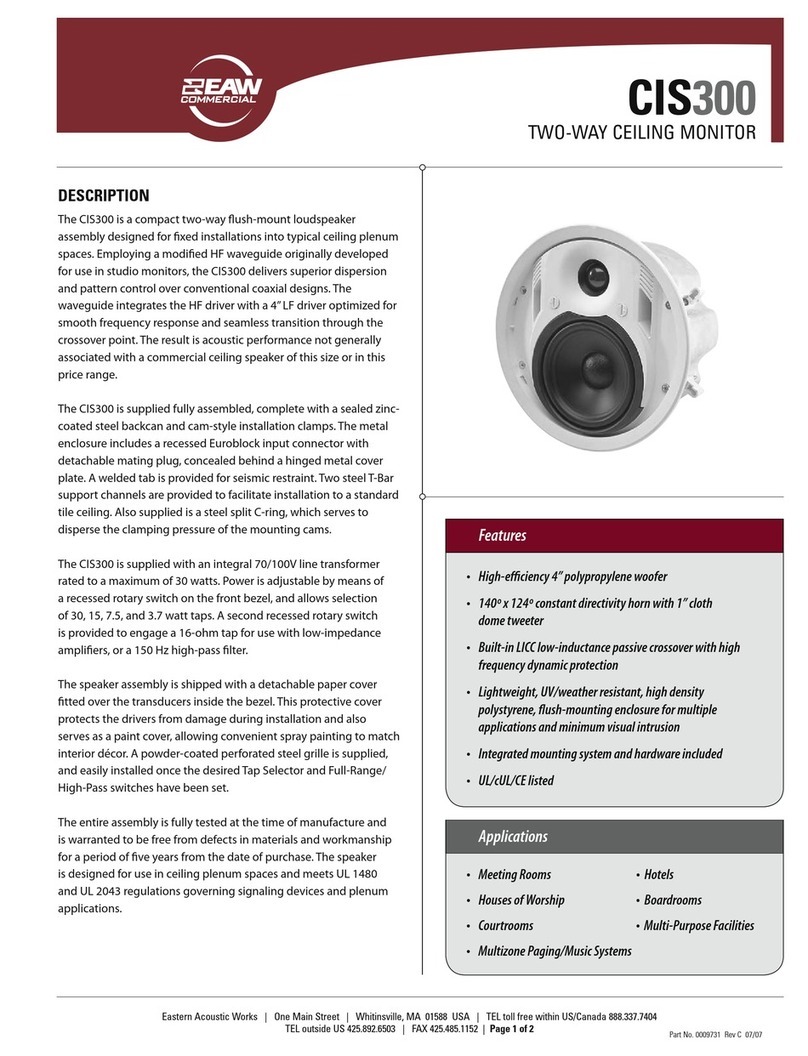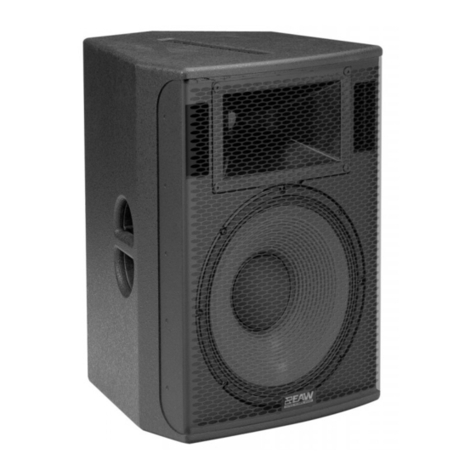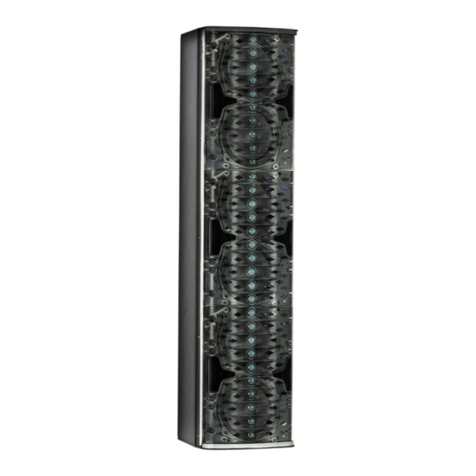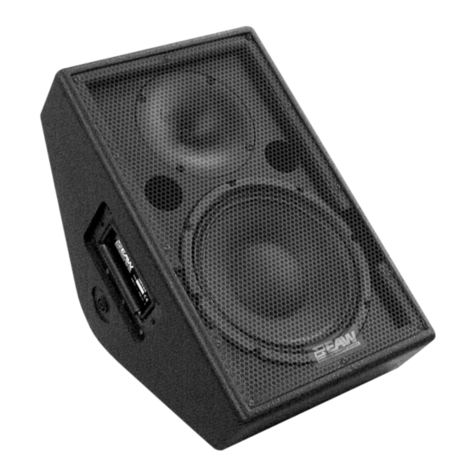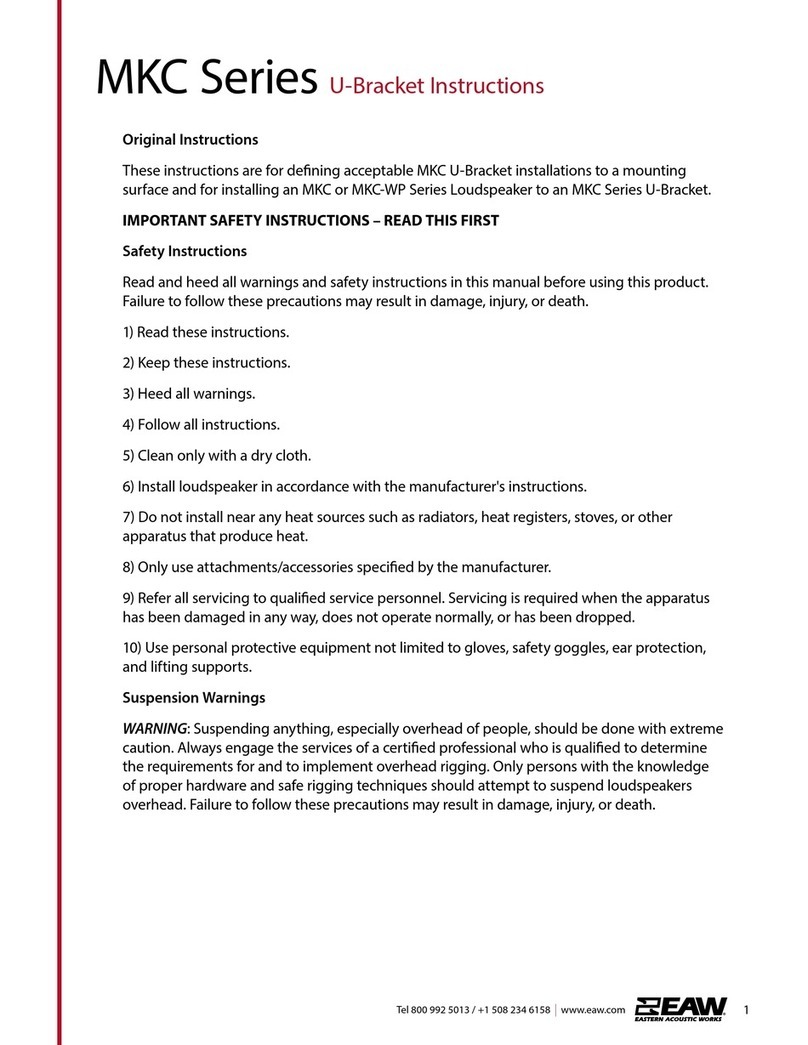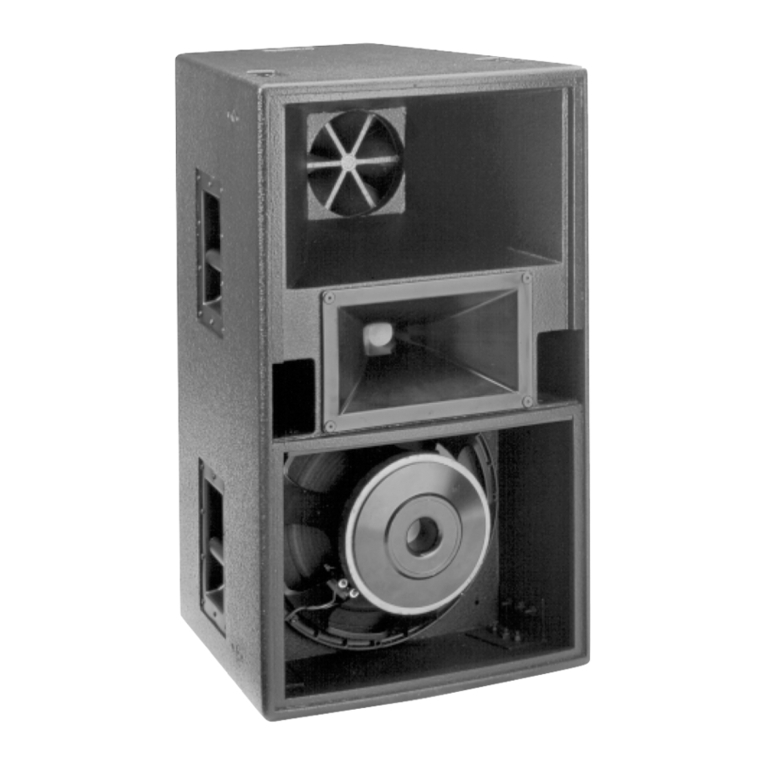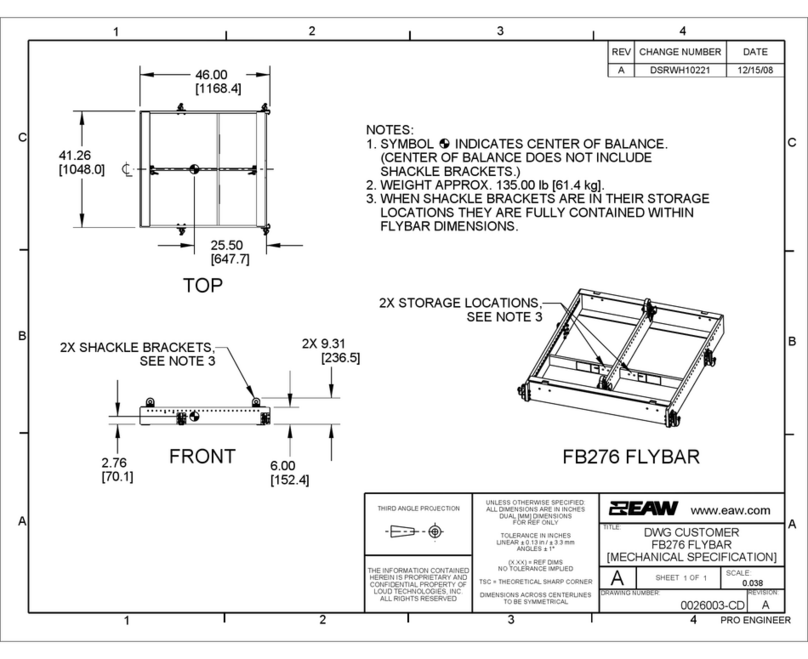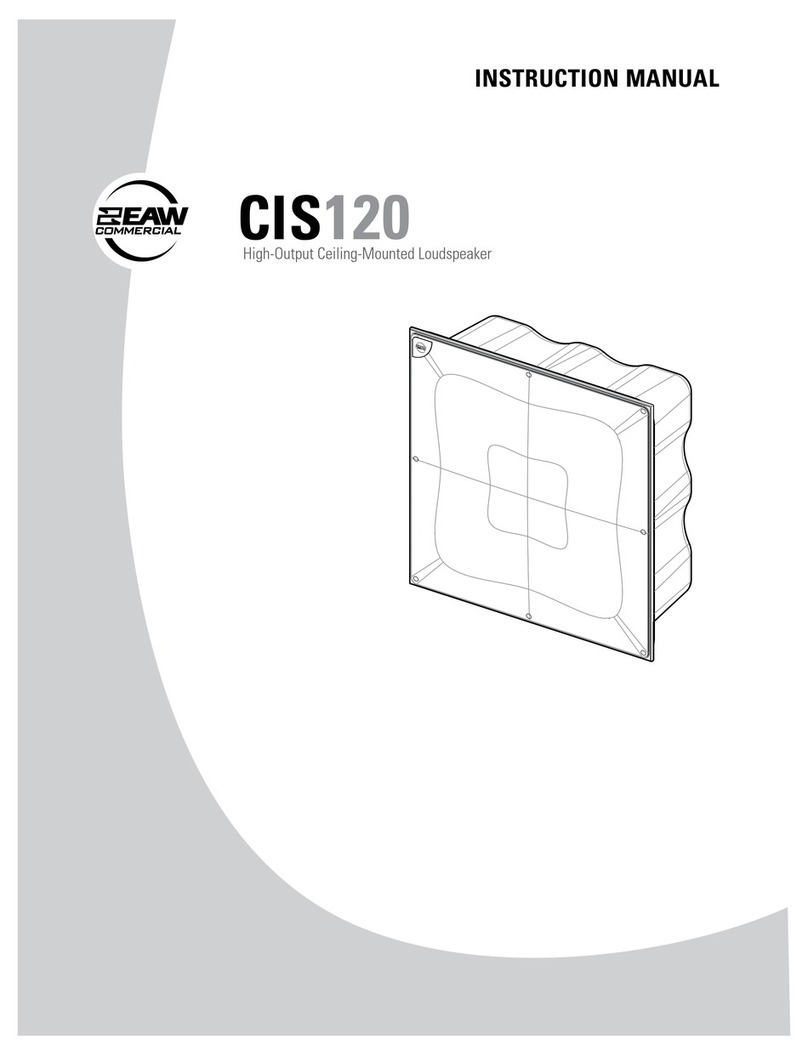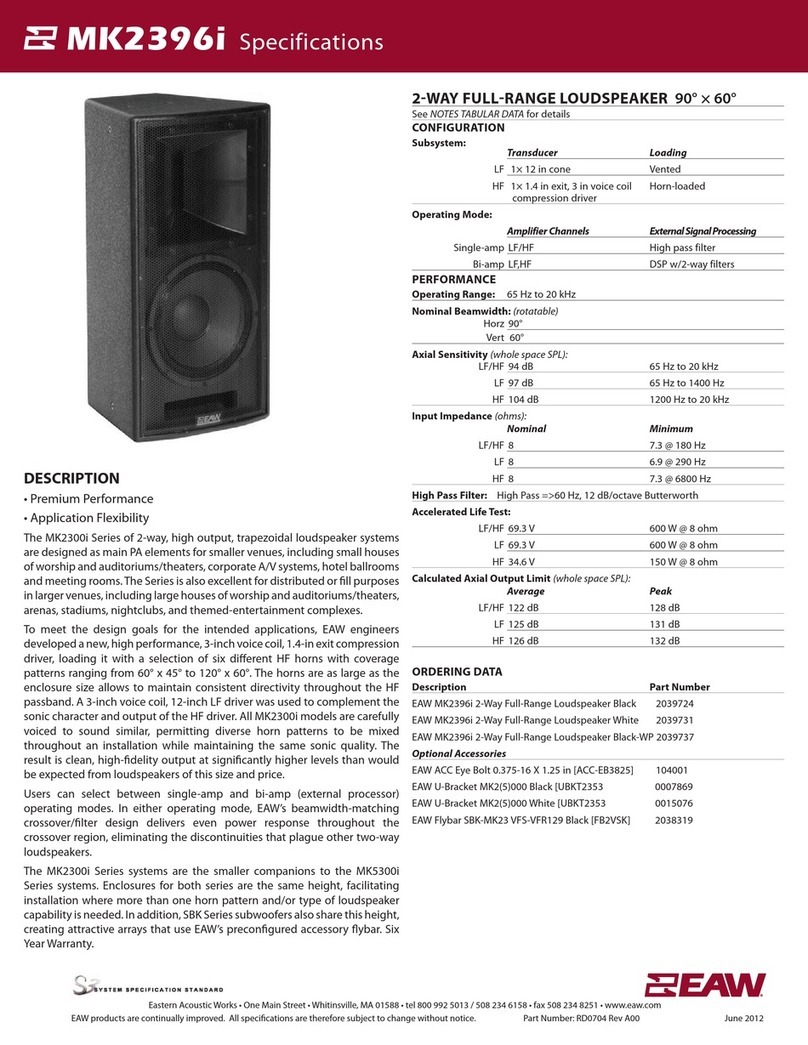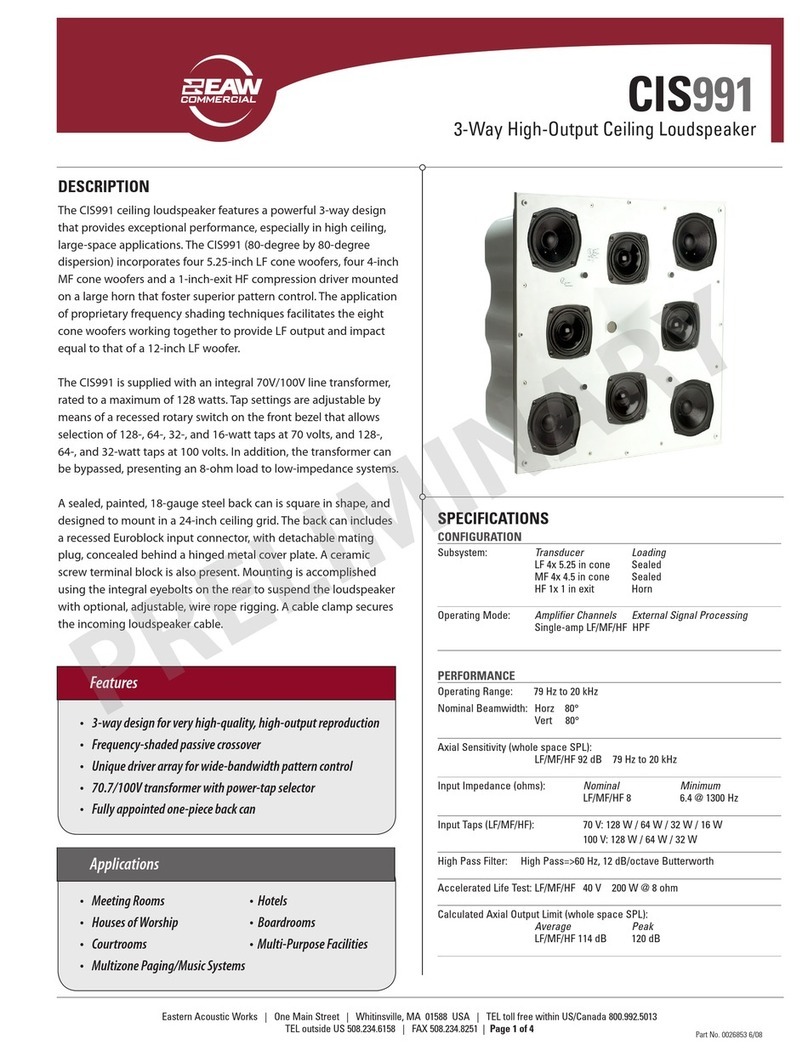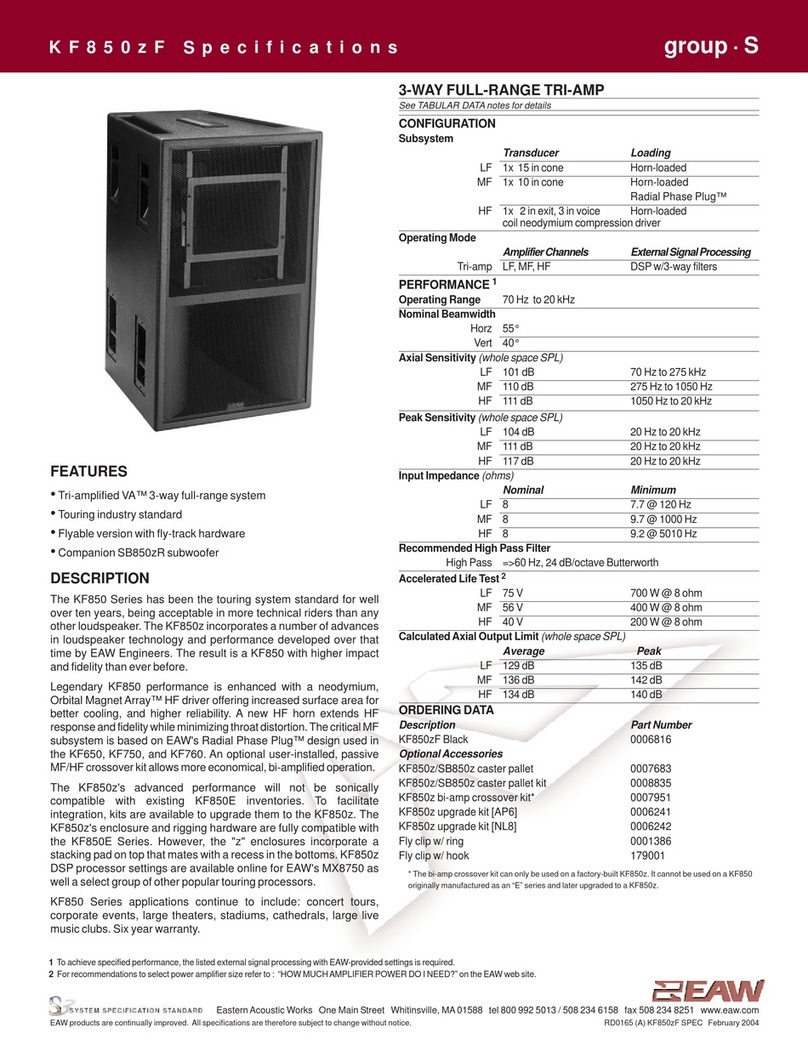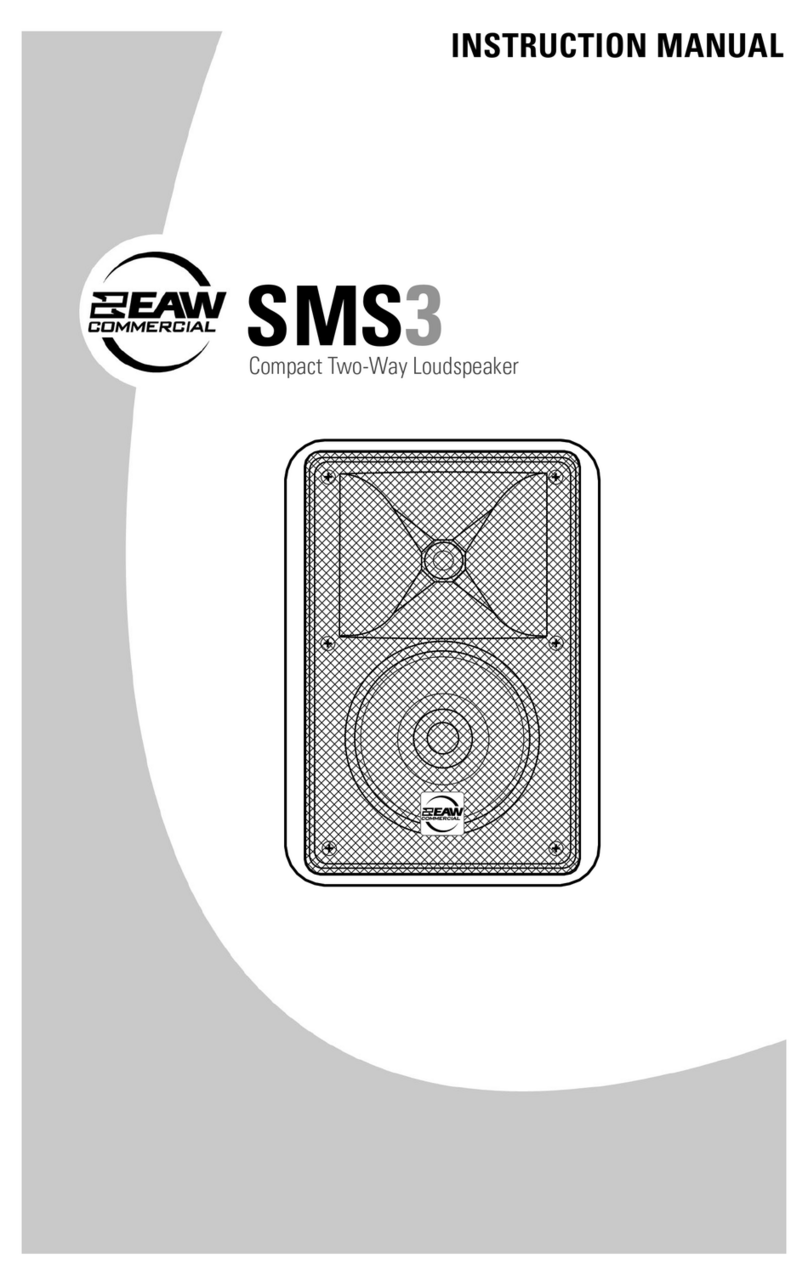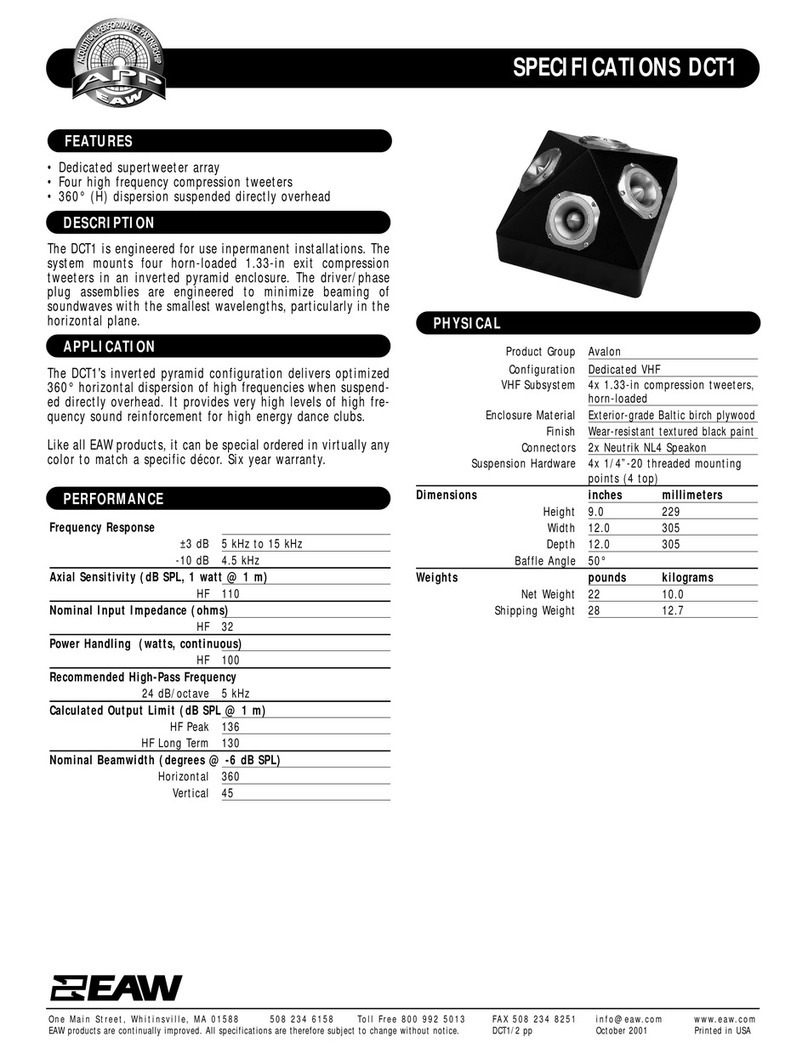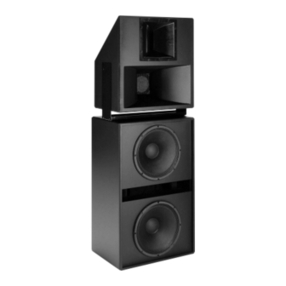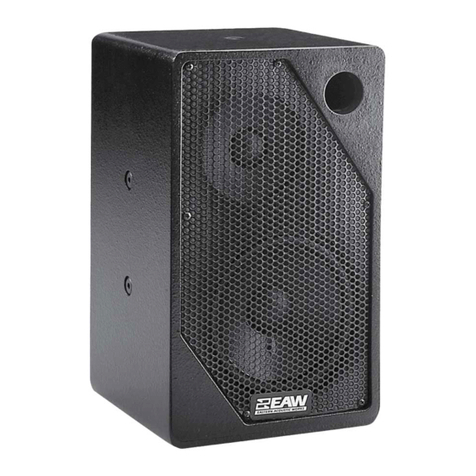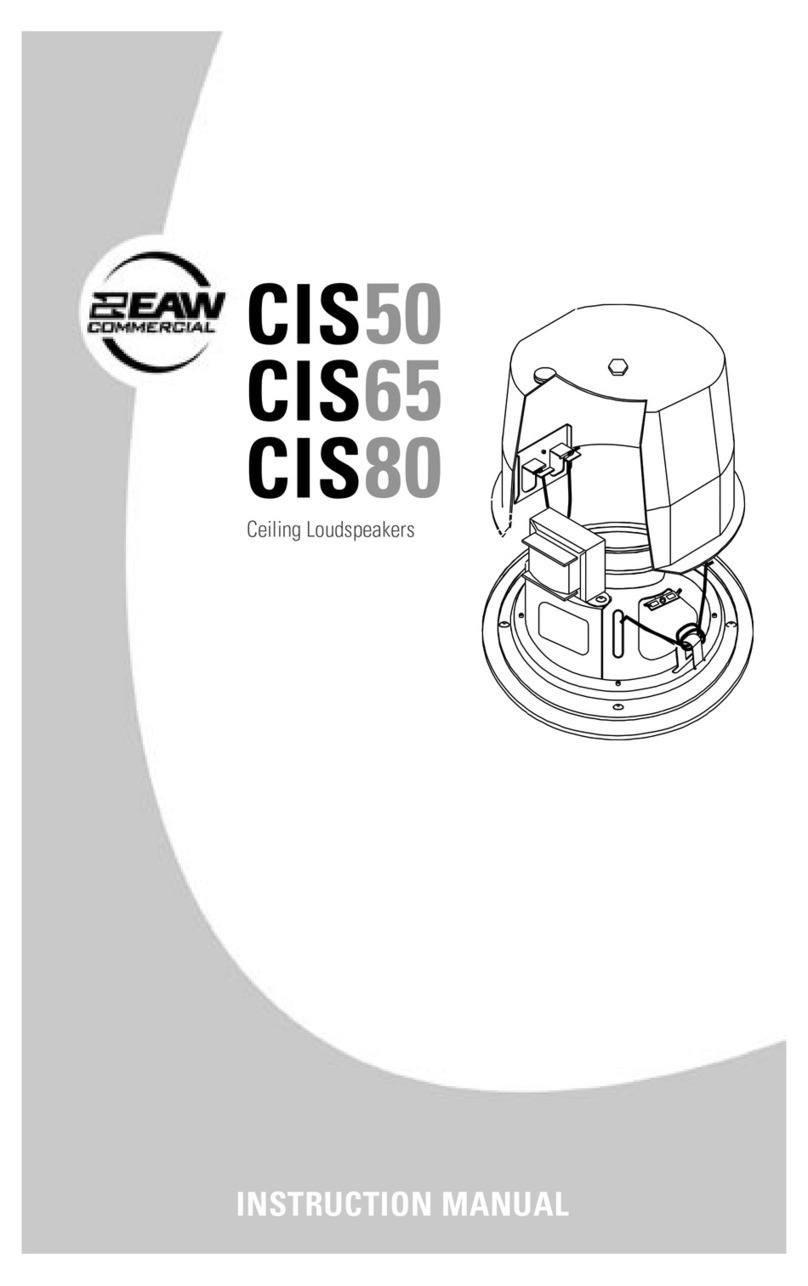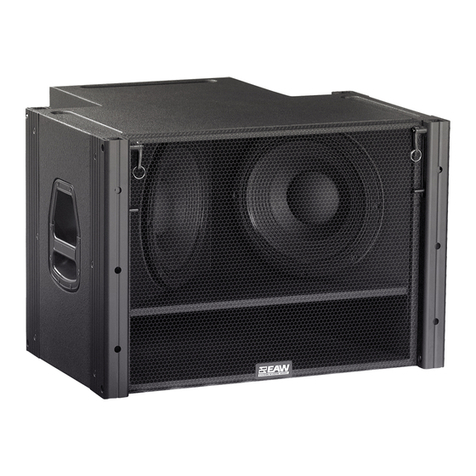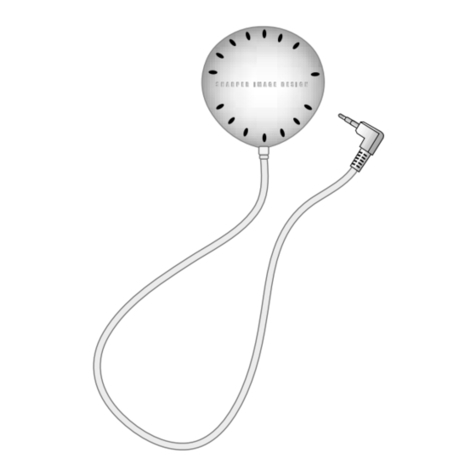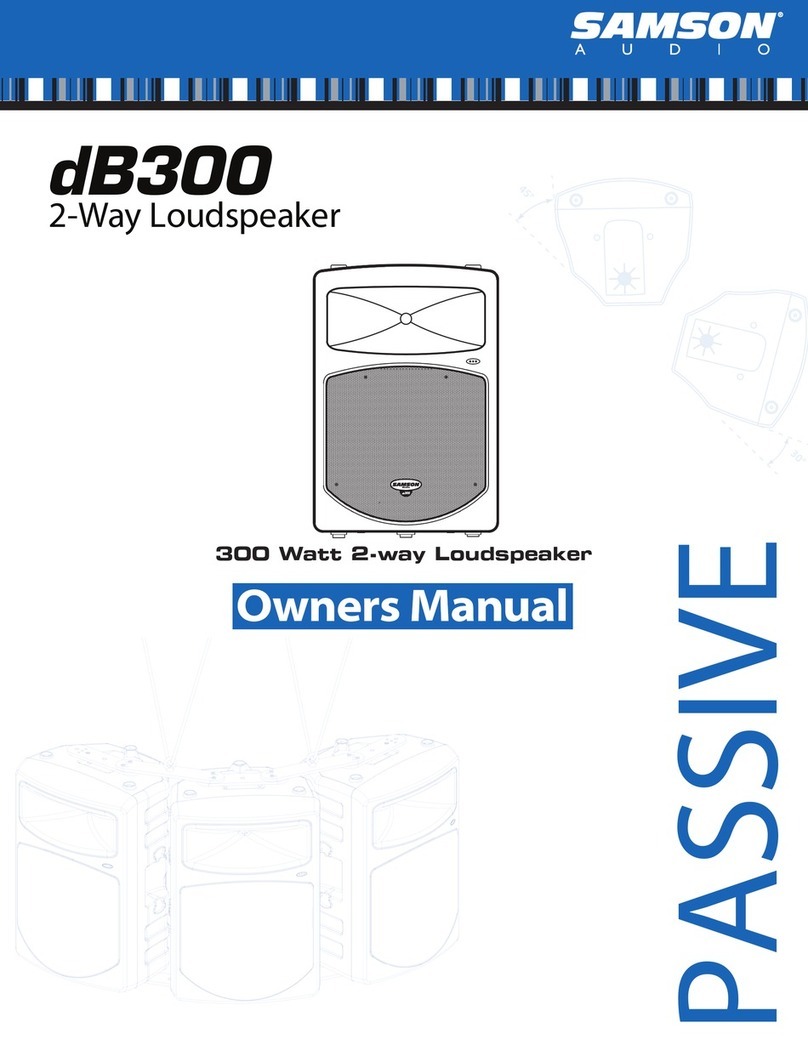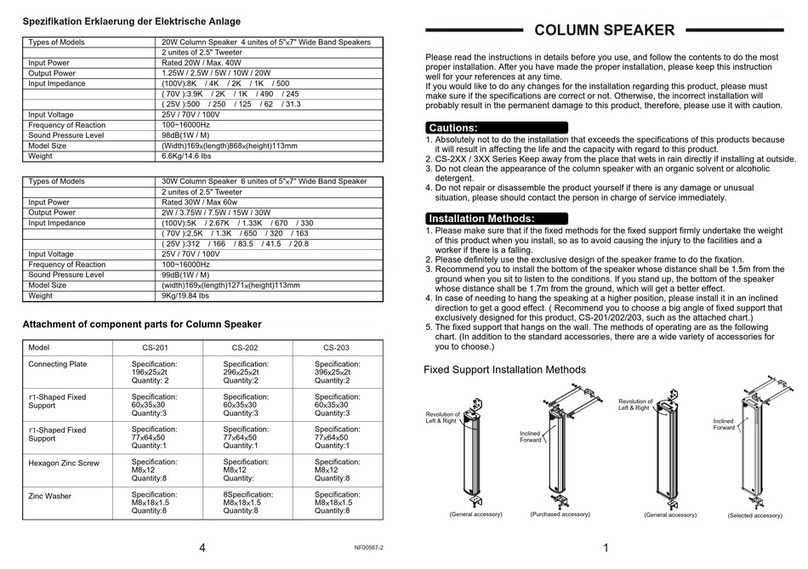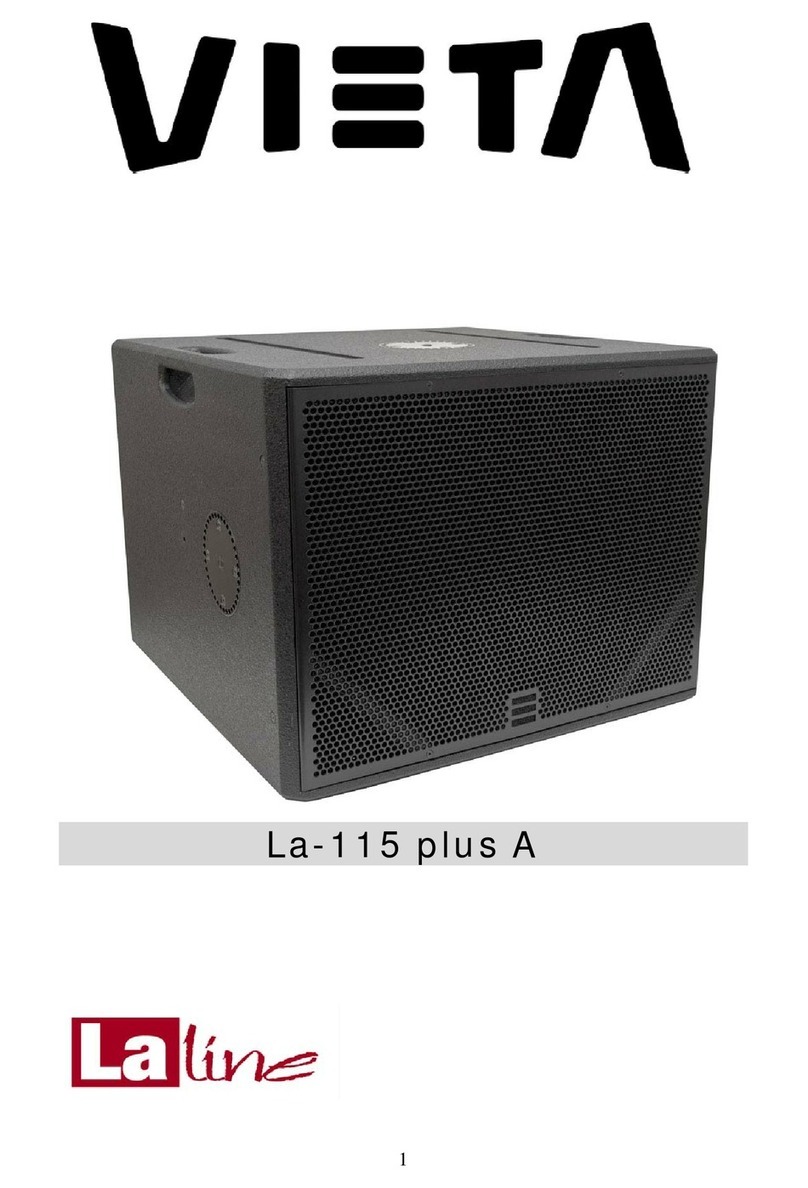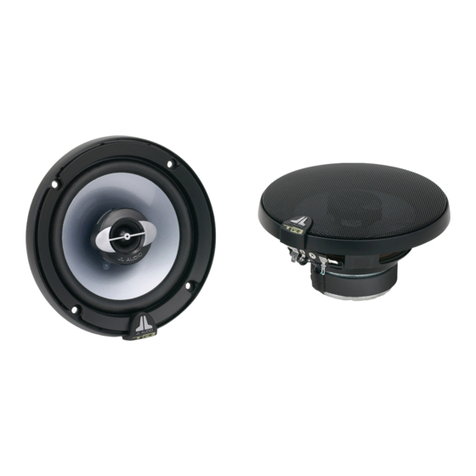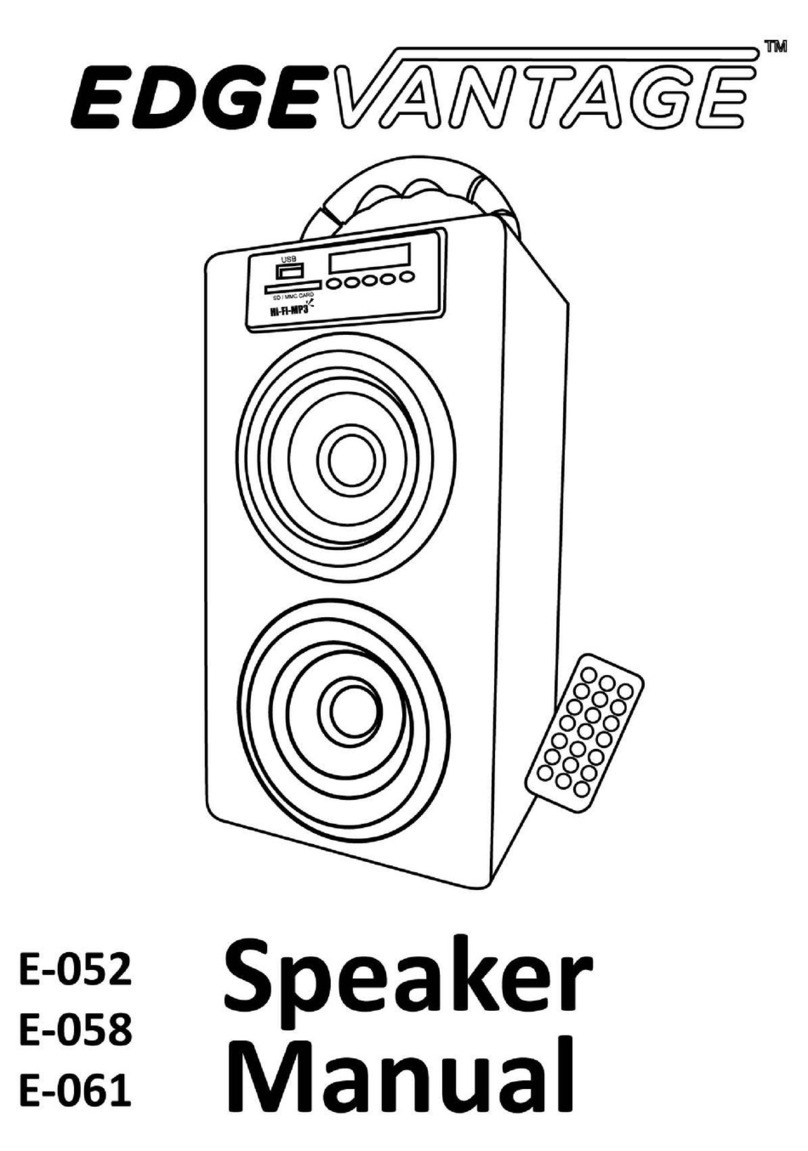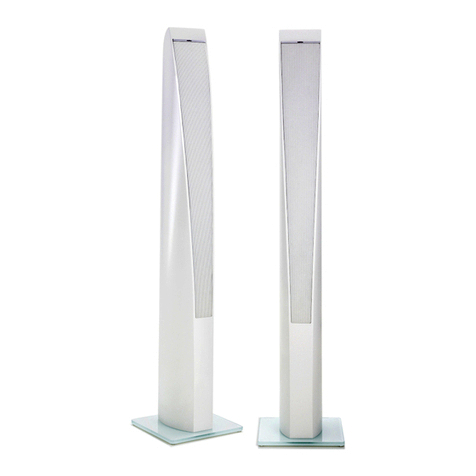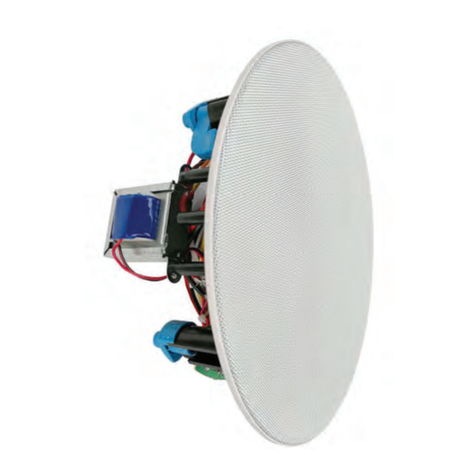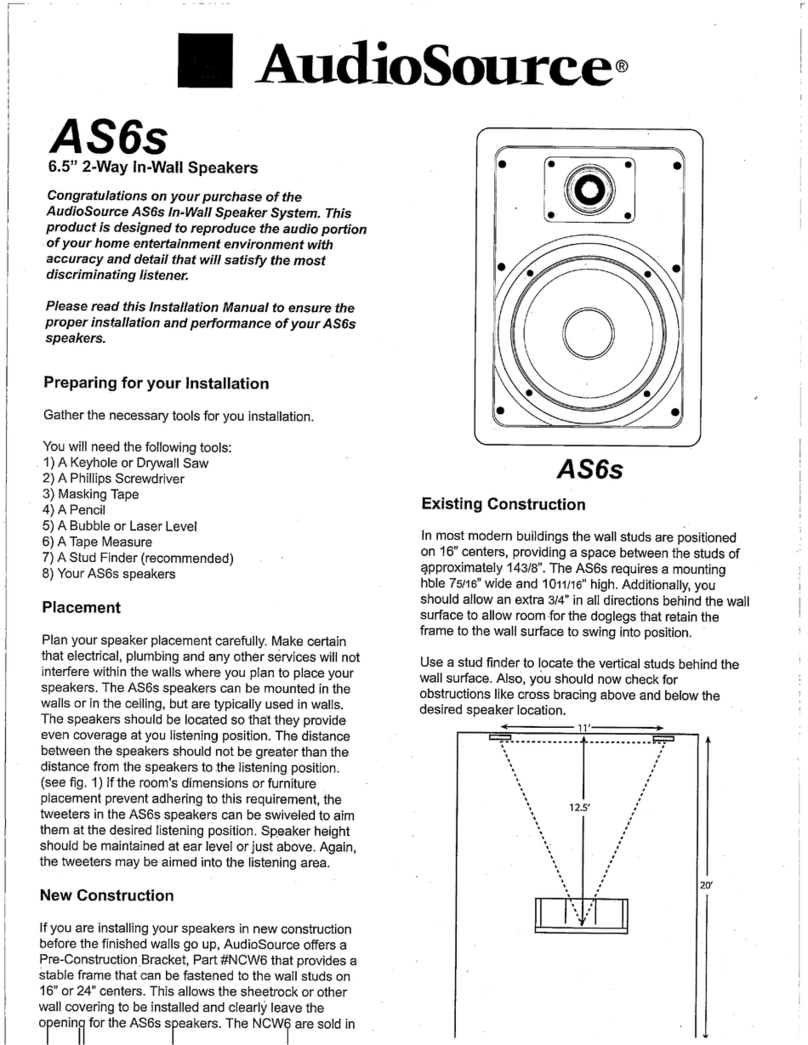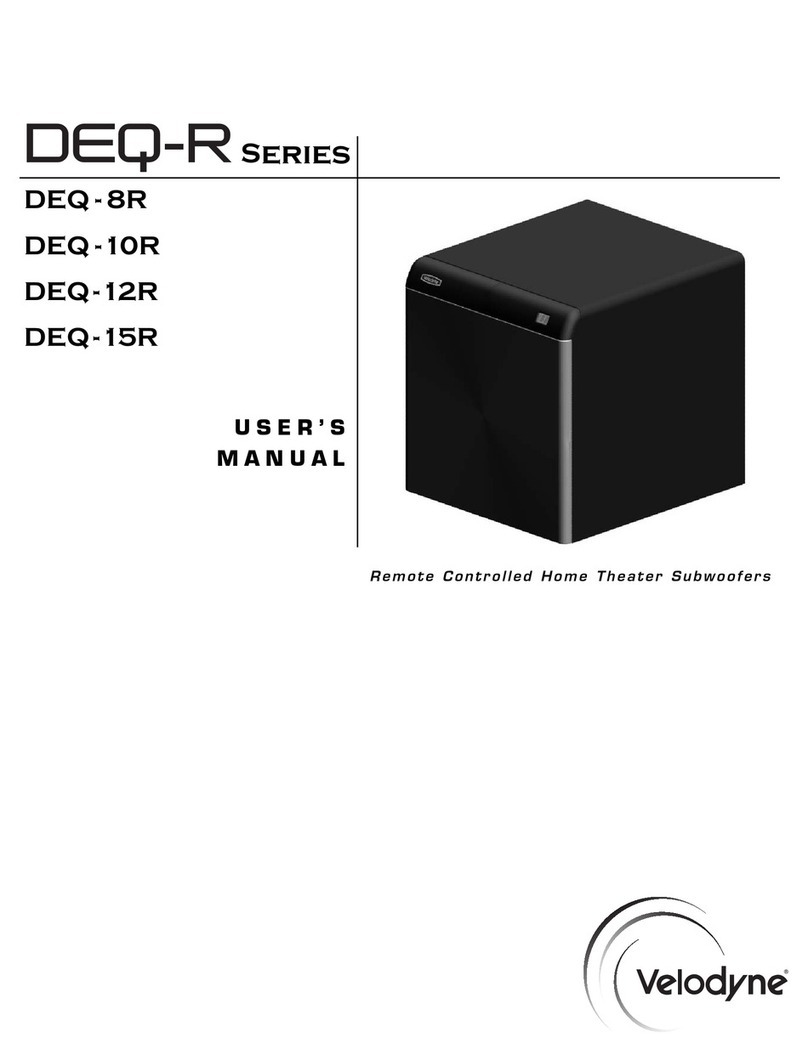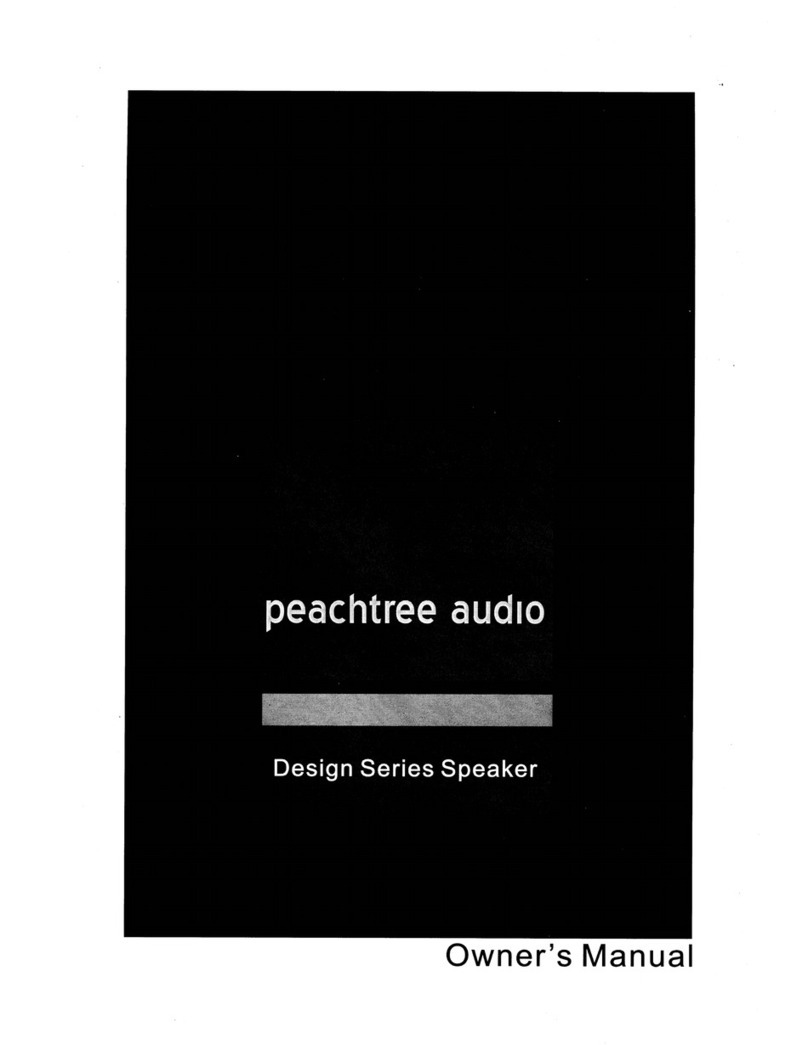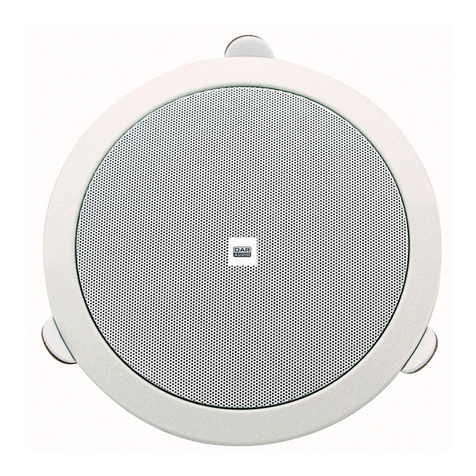EAW Loudspeaker's User manual

EAW LOUDSPEAKER
OWNER’S MANUAL
NEVERENDING INNOVATION

Loudspeaker Owner’s Manual
Congratulations on the purchase of your new EAW loudspeaker. You now
own one of the finest professional audio products available - the result of
exceptional engineering and meticulous craftsmanship.
This manual is intended for use with all EAW loudspeakers. As such, it
contains information that is common to different types of loudspeakers. This
includes: safety precautions; installation, set-up, and operating instructions;
troubleshooting, maintenance, and service procedures as well as other
information specific to their use. Certain information specific to certain
classes of loudspeaker, such as powered products, is so noted. Certain
loudspeakers with specialized designs have a manual that accompanies this
one with additional instructions and other information specific for their use.
Thus, both manuals apply to those loudspeakers.
Please read this manual plus any accompanying manual and follow all
relevant precautions and instructions. This should allow you to obtain the
maximum performance from your new loudspeaker.
Where there are conflicts or overlaps, the information in any accompanying
manual supersedes the information in this manual.
Section 1 Important Safety Precautions -Read This First
Read and heed all warnings and safety instructions in this Manual before using the product.
Failure to follow all precautions can result in equipment damage, personal injury, or death.
1.1 Important Safety Instructions for Powered Loudspeakers
The lightning flash with arrowhead symbol within an equilateral triangle is intended to alert
the user to the presence of uninsulated "dangerous voltage" within the product's enclosure
that may be of sufficient magnitude to constitute a risk of electric shock to persons.
The exclamation point within an equilateral triangle is intended to alert the user of the
presence of important operating and maintenance (servicing) instructions in the literature
accompanying the appliance.
1. Read these instructions.
2. Keep these instructions.
3. Heed all warnings.
4. Follow all instructions.
5. Do not use this apparatus near water.
6. Clean only with dry cloth.
7. Do not block any ventilation openings. Install in accordance with the manufacturer's
instructions.
ii

8. Do not install near any heat sources such as radiators, heat registers, stoves, or other
apparatus (including amplifiers) that produce heat.
9. Do not defeat the safety purpose of the polarized or grounding-type plug. A polarized
plug has two blades with one wider than the other. A grounding type plug has two blades
and a third grounding prong. The wide blade or the third prong is provided for your
safety. If the provided plug does not fit into your outlet, consult an electrician for
replacement of the obsolete outlet.
10. The power plug at the wall must remain accessible to be able to disconnect power from
the apparatus.
11. Protect the power cord from being walked on or pinched particularly at plugs, convenience
receptacles, and the point where they exit from the apparatus.
12. Only use attachments/accessories specified by the manufacturer.
13. Use only with the cart, stand, tripod, bracket, or table specified by the manufacturer, or
sold with the apparatus. When a cart is used, use caution when moving the cart/apparatus
combination to avoid injury from tip-over.
14. Unplug this apparatus during lightning storms or when unused for long periods of time.
15. Refer all servicing to qualified service personnel. Servicing is required when the
apparatus has been damaged in any way, such as power-supply cord or plug is damaged,
liquid has been spilled or objects have fallen into the apparatus, the apparatus has been
exposed to rain or moisture, does not operate normally, or has been dropped.
16. This apparatus shall not be exposed to dripping or splashing, and no object filled with
liquid, such as vases, shall be placed on the apparatus.
17. This apparatus has been designed with Class-I construction and must be connected to
a mains socket outlet with a protective earthing connection (the third grounding prong).
18. This apparatus does not exceed the Class A/Class B (whichever is applicable) limits for
radio noise emissions from digital apparatus as set out in the radio interference
regulations of the Canadian Department of Communications.
ATTENTION: -Le présent appareil numérique n'émet pas de bruits radioélectriques dépassant las
limites applicables aux appareils numériques de class A/de class B (selon le cas) prescrites dans le
règlement sur le brouillage radioélectrique édicté par les ministere des communications du Canada.
19. If the loudspeaker is exposed to changes in temperature and humidity, internal condensation
may develop. If powered up with such condensation, electronic failure could result. When
exposed to environmental changes, allow the loudspeaker at least 30 minutes to
acclimate to a new temperature before connecting to the ac mains and operating.
20. EAW loudspeakers can produce sound levels capable of causing permanent hearing damage
from prolonged exposure. The higher the sound level, the less exposure needed to cause
such damage. Avoid prolonged exposure to the high sound levels from the loudspeaker.
DANGER: There is danger of explosion if battery is incorrectly replaced. Replace only with the
same or equivalent type. This applies to any loudspeakers with a battery.
WARNING: TO REDUCE THE RISK OF FIRE OR ELECTRIC SHOCK, DO NOT EXPOSE THIS
APPLIANCE TO RAIN OR MOISTURE. DO NOT EXPOSE THE APPARATUS TO DRIPPING OR
SPLASHING AND DO NOT PLACE OBJECTS FILLED WITH LIQUIDS, SUCH AS DRINKS, ON
THE APPARATUS.
CAUTION: This product is energized as long as it is connected to the AC mains supply.
CAUTION: Allow at least six inches of free space all around the amplifier heat sink for
sufficient ventilation.
iii

En cas de conflit d'informations, les informations fournies dans les brochures ou manuels
accompagnant le produit annulent et remplacent celles de ce manuel.
1. CONSIGNES DE SÉCURITÉ- ÀLIRE EN PREMIER
Lisez et respectez toutes les consignes de sécuritéde ce manuel avat d'utiliser le produit. Le
non-respect de ces consignes de sécuritépeut entraîner des dommages matériels ou des
accidents aux personnes qui peuvent être fatals.
1.1 CONSIGNES DE SÉCURITÉIMPORTANTES RELATIVES AUX ENCEINTES ACTIVES
Le symbole del'éclair dans le triangle équilatéral prévient l'utilisateur de la présence d'une
"tension électrique dangereuse" dans le produit constituant un risque d'électrocution.
Le point d'exclamation dans le triangle équilatéral prévient l'utilisateur de la résence
d'instructions importantes relatives àl'utilisation et àla maintenance du produit dans le
manuel fourni avec le produit.
1. Lisez ces instructions.
2. Conservez ces instructions.
3. Respectez toutes les mises en garde.
4. Suivez toutes les intructions.
5. Ne pas utiliser cet appareil près d'une source liquide.
6. Nettoyer uniquement avec un tissu sec.
7. Ne pas obstruer les ouïes de ventilation. Installer selon les instructions du fabriquant.
8. Ne pas installer près d'une source de chaleur cmme des radiateurs, convecteurs, poêles,
ou près de tout appareil (ce qui comprend les amplificateurs de puissance) produisant
de la chaleur.
9. Ne pas modifier la sécuritéofferte par les fiches secteur polarisées ou avec mise àla
terre. Les fiches polaisées sont équipées de deux lames, dont une plus large que l'autre.
Les fiches avec mise àla terre disposent d'un troisième plot. La mise àla terre garantit
la sécuritédes utilisateurs. Si la fiche fournie ne correspond pas au format de vos prises
sectur, consultez un électricien qui pourra les remplacer.
10. La fiche secteur dans la prise murale doit rester accessible pour
permettre la déconnexion de l'appareil du secteur.
11. Protéger le cordon secteur de toute dégradation de sorte que les personnes e puissent
pas marcher dessus. Veiller àne pas pincer le cordon secteur, de sa sortie de l'appareil,
jusqu'àla connexion dans la prise murale ou autre.
12. Utiliser uniquement les fixations/accessoires spécifiés par le fabriquant.
13. Utiliser uniquemen le chariot, pied, tripode, fixation, ou la table spécifiés par le
fabriquant, ou vendus avec l'appareil. Lors de l'utilisation d'un chariot, vérifier la
stabilitéde l'ensemble chariot/équipement pour éviter toute chute et tout accident.
14. Déconnecter 'appareil du secteur en cas d'orage ou de périodes d'inutilisation prolongées.
15. Confier toutes les réparations àun personnel qualifié. L'appareil doit être réparélorsqu'il
a étéendommagé, lorsque le cordon ou la fiche secteur ont étéendommagés, los de
l'infiltration d'un liquide ou d'un objet dans l'appareil, lorsque l'appareil a étéexposé
àla pluie ou àl'humidité, s'il ne fonctionne pas correctement, ou s'il a subi une chute.
16. Cet appareil ne doit être exposéàaucune source de projection lquide. Ne pas placer
d'objet contenant un liquide sur l'appareil (verre, vase, etc.).
17. Cet appareil répond aux normes de fabrication de Classe I et doit impérativement être
connectéàune ligne secteur avec terre.
18. Cet appareil répond aux normes de lasse A/Classe B numériques du Département
Canadien des Communications (lorsque celles-ci sont applicables) sur les émissions
radio générées par les équipements.
iv

19. Si l'enceinte est exposée àdes variations de température et d'humidité, il se peut qu'un
condensation interne se produise. La mise sous tension de l'appareil en présence de cette
condensation peut entraîner une panne électrique. Si l'appareil est exposéàde telles
variations, attendez au moins 30 minutes avant de relier l'appareil au secteu et de l'utiliser.
20. Les enceintes EAW peuvent produire des niveaux sonores capables de causer des
dommages irréversibles àl'audition en présence d'une exposition prolongée. Plus le
niveau sonore est élevé, moins la durée d'exposition est longue avantde causer de tels
dommages. Évitez toute exposition prolongée aux niveaux sonores élevés.
DANGER: Danger d'explosion en cas de non remplacement correct de la pile. Remplacez
uniquement par une pile identique ou équivalente. Ceci s'applique à toutes les eceintes
équipées d'une pile.
ATTENTION: Pour réduire les risques d'incendie ou d'électrocution, ne pas exposer cet
appareil àla pluie ou àl'humidité. Ne pas exposer aux projections liquides et ne pas placer
d'objet contenant un liquide sur l'appareil (oisson, verre, etc.).
ATTENTION: Cet appareil est sous tension tant qu'il est connectéau secteur.
ATTENTION: Laisser au moins quinze centimètres autour du radiateur de l'amplificateur pour
assurer sa ventilation.
In caso di incongruenze, le informazioi riportate in ogni singolo manuale allegato al prodotto
sostituiscono quelle presenti in questo manuale.
1. PRECAUZIONI DI SICUREZZA - DA LEGGERE PER PRIMO
Leggere e rispettare le avvertenze e le norme di sicurezza riportate in questo Manuale prima di
uilizzare il prodotto. Il mancato rispetto di ogni precauzione puòcausare danni
all'apparecchiatura, nonchéinfortuni alle persone o la morte.
1.1 IMPORTANTI NORME DI SICUREZZA PER L'USO DI DIFFUSORI ATTIVI
Il simbolo del lampo con la punta a freccia, racchiuso in un triangolo equilatero, avverte
l'utente della presenza di un voltaggio pericoloso non isolato all'interno del prodotto,
sufficientemente alto a causare il rischio di shock elettrico alle persone.
Il punto esclamativo all'interno di un tiangolo equilatero, avverte l'utente della presenza di
importanti istruzioni operative e di mantenimento (assistenza tecnica) nella documentazione
che accompagna il prodotto.
1. Leggere queste istruzioni.
2. Conservare queste istruzioni.
3. Prestare atenzione ad ogni avvertenza.
4. Seguire tutte le istruzioni.
5. Non utilizzare l'unitànelle vicinanze di acqua.
6. Pulire unicamente con un panno asciutto.
7. Non ostruire nessuna apertura adibita alla ventilazione. Effettuare l'installazione
seguend le istruzioni del costruttore.
8. L'unitàdev'essere posizionata in un luogo lontano da fonti di calore come caloriferi,
stufe o altre apparecchiature che producono calore (inclusi gli amplificatori).
v

9. Non annullare la sicurezza garantita dall'utilizz di spine polarizzate o con messa a
terra. Le spine polarizzate sono caratterizzate dalla presenza di due lamine, una più
grande dell'altra. Le spine con messa a terra sono caratterizzate dalla presenza di due
lamine e di un "dente" per la messa a terra. a lamina maggiore e il "dente" per la messa
a terra sono contemplate per garantire la tua sicurezza. Nel caso in cui la spina del cavo
incluso non si inserisca perfettamente nella presa, si prega di contattare un elettricista
per effettuarne la sostituzioe.
10. La presa di corrente alla parete dev'essere sempre facilmente accessibile, per consentire
la disconnessione dell'alimentazione dall'apparato.
11. Proteggere il cavo di corrente dall'essere calpestato o tirato, in particolare la presa e il
punto in ui il cavo esce dall'unità.
12. Utilizzare unicamente estensioni/accessori specificati dal costruttore.
13. Utilizzare esclusivamente carrelli, supporti, treppiedi, staffe, o altro specificato dal
costruttore o venduto insieme all'unità. Usando un carrell, fare attenzione a non
rovesciare l'unitàdurante la movimentazione.
14. Disconnettere l'unitàdalla presa di corrente durante forti temporali o lunghi periodi di
inutilizzo.
15. Ogni riparazione deve essere effettuata da personale qualificato. L'assisteza èrichiesta
quando l'unitàrisulta danneggiata in qualsiasi modo, ad esempio: cavo di corrente o
presa danneggiata, del liquido o degli oggetti sono caduti all'interno, l'unitàèstata
esposta all'umiditào alla pioggia, l'unitànon funziona correttamete oppure ècaduta.
16. Non esporre questa unitàa gocce o schizzi di alcun liquido. Non posizionare sull'unità
oggetti contenenti liquido, come vasi o bicchieri.
17. Questa unitàèstata progettata in Classe-I e deve essere collegata ad una presa di corrnte
con messa a terra (spina con terzo "dente" per la messa a terra).
18. Questa unitànon oltrepassa le limitazioni di Classe A/Classe B (dove applicabile)
relative alle emissioni di rumore radio generate da apparecchiature digitali, in
conformitàalle egolamentazioni riguardanti le interferenze radio emesse dal Canadian
Department of Communications.
19. Se il diffusore èsottoposto a variazioni di temperatura e all'umidità, si puòsviluppare
della condensa all'interno. L'attivazione dell'unitàin presnza di condensa, puòcausare
problemi al sistema elettrico. In caso di esposizione a cambiamenti climatici, è
necessario permettere al diffusore di acclimatarsi alla nuova temperatura per almeno
30 minuti, prima di collegarlo alla presa di corrente e inizare l'utilizzo.
20. I diffusori EAW sono in grado di generare livelli sonori che possono causare danni
permanenti all'udito in caso di esposizione prolungata. Maggiore èil livello del segnale
audio, minore èil tempo di esposizione necessario a causare ali danni. Quindi, in caso
di utilizzo di livelli sonori elevati, evitare un'esposizione prolungata.
PERICOLO: Se la batteria viene sostituita in modo non corretto, c'èil rischio di esplosione.
Effettuare la sostituzione utilizzando una batteria dello sesso tipo o equivalente. Questa
norma èvalida per qualsiasi diffusore dotato di batteria.
ATTENZIONE: Per ridurre il rischio di incendio o scossa elettrica, non esporre l'unitàalla
pioggia o all'umidità. Non esporre questa unitàa gocce o schizzi di alun liquido, e non
posizionare sull'unitàoggetti contenenti liquido, come vasi o bicchieri.
CAUTELA: Questa unitàèalimentata fino a quando ècollegata alla presa di corrente.
ATTENZIONE: Lasciare uno spazio di almeno 15 cm intorno al dissipatore dell'limentatore,
per permettere una sufficiente ventilazione.
vi

En caso de cualquier conflicto o duplicación, la información que se adjunte en el manual que
acompañe a este documento sustituye a la información contenida en estas páginas.
1. PRECAUCIONES DE SEURIDAD - LEA ESTO PRIMERO
Lea y respete todas las instrucciones de seguridad y aviso que aparezcan en este manual antes
de comenzar a usar este aparato. El no cumplir con lo indicado en esas precauciones puede
dar lugar a daños en el aparato, daños persoales o incluso la muerte.
1.1 AVISO IMPORTANTE DE SEGURIDAD PARA ALTAVOCES AUTOAMPLIFICADOS
El símbolo del rayo dentro de un triángulo equilátero quiere advertir al usuario de la presencia
de "voltajes peligrosos" no aislados dentro de la carcasa de ese aparato, que pueden ser de
magnitud suficiente como para constituir un riesgo de descargas eléctricas a las personas.
El símbolo de exclamación dentro de un triángulo equilátero quiere advertir al usuario de la
existencia de instrucciones importante relativas al manejo y mantenimiento (reparaciones) en
los documentos que se adjuntan con el aparato.
1. Lea estas instrucciones.
2. Siga todas las indicaciones.
3. Cumpla con todas las precauciones.
4. Observe todas las instrucciones.
5. No utilice est aparato cerca del agua.
6. Limpie esta unidad solo con un trapo seco.
7. No bloquee ninguna de las aberturas de ventilación. Instale el aparato de acuerdo a las
instrucciones del fabricante.
8. No instale este aparato cerca de ninguna fuente de calor com radiadores, calentadores,
hornos u otros aparatos (incluyendo amplificadores) que produzcan calor.
9. No anule el sistema de seguridad que supone un enchufe polarizado o con toma de
tierra. Un enchufe polarizado tiene dos bornes de distinto tamaño; uno cn toma de
tierra tiene dos bornes iguales y una lámina para la conexión a tierra. El borne ancho
o la lámina se incluyen para su seguridad. Si el enchufe que venga con su unidad no
encaja en su salida de corriente, póngase en contacto con un electricista ara que
sustituya esa salida obsoleta.
10. El enchufe de salida de corriente debe quedar accesible para que
pueda desconectar el cable del aparato en cualquier momento y sin problemas.
11. Evite que el cable de corriente pueda ser pisado o que quede aplstado, especialmente
en los conectores, receptáculos y en el punto de unión con el aparato.
12. Utilice solo accesorios/complementos especificados por el fabricante.
13. Utilice este aparato solo con un soporte, bastidor o rack especificado por el fabricate o
que se venda con el propio aparato. Cuando utilice un bastidor con ruedas, tenga
cuidado al mover la combinación soporte/aparato para evitar que pueda volcar.
14. Desconecte este aparato de la corriente eléctrica durante las tormentas o cuando no lo
aya a usar durante un periodo de tiempo largo.
15. Consulte cualquier posible reparación solamente al servicio técnico oficial. Este
aparato deberáser revisado cuando se haya dañado de alguna forma, como en el caso
de un daño en el cable de corriente o onector, si se ha derramado algún líquido sobre
la unidad, si el aparato ha quedado expuesto a la lluvia o la humedad, si no funciona
normalmente o si ha caído al suelo.
16. No permita que este aparato quede expuesto a salpicaduras de líquidos, ni coloqueobjetos
que contengan líquidos (como un florero, por ejemplo) encima de este aparato.
17. Este aparato ha sido diseñado con una construcción de clase I y debe ser conectado a
vii

una salida de corriente que disponga de una conexión a tierra de protección (la ercera
lámina que indicamos antes).
18. Este aparato no sobrepasa los límites de la clase A/clase AB (cualquiera que sea la
aplicable) en cuanto a emisión de ruidos de radio de aparatos digitales, de acuerdo a
lo que viene estipulado en las leyes sobre inerferencias del departamento canadiense de
comunicaciones.
19. Si el altavoz queda expuesto en algún momento a cambios de temperatura o de
humedad, puede producirse condensación de agua en su interior. Si enciende la unidad
mientras se produce esa condensción, se puede producir una avería eléctrica. Por ese
motivo, cuando la unidad quede expuesta a cambios
medioambientales, deje un espacio de al menos 30 minutos para que el altavoz se
aclimate a la nueva temperatura antes de conectarlo y usarlo.
20. Los ltavoces EAW son capaces de producir niveles de presión sonora capaces de
producir daños permanentes en la capacidad auditiva en caso de una exposición
prolongada a los mismos. Cuanto mayor sea el nivel de sonido, menor tendráque ser
el grado de exposicin para producir tal tipo de daños. Evite una exposición
prolongada a altos niveles de presión sonora de este aparato.
PELIGRO: Existe el riesgo de una explosión si las pilas no son sustituidas de forma correcta.
Sustituya las pilas solo por otras igualeso de tipo equivalente. Esto se aplica a cualquier tipo
de altavoz que use una pila.
ATENCION: Para reducir el riesgo de incendios o descargas eléctricas, no permita que este
aparato quede expuesto a la lluvia o a un elevado nivel de humedad. No permita qe se
derrame ningún líquido sobre este aparato, y no coloque aparatos que contengan líquidos
encima de la unidad.
PRECAUCION: Este aparato estarácargado con energía mientras siga conectado a una salida
de corriente eléctrica.
PRECAUCION: Deje un espaci libre de como mínimo 15 centímetros alrededor del disipador
de calor del amplificador para su correcta ventilación.
Sollte es Widersprüche oder Überlappungen geben mit anderen Produktanleitungen geben, so
treten diese Passagen an die entsprechenden Stelen in dieser Anleitung.
1. SICHERHEITSHINWEISE - ZUERST LESEN
Lesen und beachten Sie alle Warnungen und Sicherheitsanweisungen dieser
Bedienungsanleitung vor der Benutzung des Produkts. Nichtbeachtung dieser Hinweise
können möglicherweise zu Schäden am Equipment oder zu Verletzungen bzw. zum Tod von
Personen führen.
1.1 WICHTIGE SICHERHEITSANWEISUNGEN FÜR AKTIVE LAUTSPRECHER
Das Blitzsymbol im gleichschenkligen Dreieck ist ein Warnzeichen für das Vorhandensein von
nicht isolierter Spannung innerhalbdes Gehäuses. Diese Spannung kann gefährlich hoch sein,
so dass die Gefahr eines elektrischen Schlages besteht.
Das Ausrufezeichen im gleichschenkligen Dreieck macht auf einen wichtigen Betriebs- oder
Servicehinweis aufmerksam, der in der zum Gerät geörenden Anleitung nachgeschlagen
werden kann.
viii

1. Lesen Sie diese Anleitung.
2. Bewahren Sie diese Anleitung auf.
3. Beachten Sie alle Warnhinweise.
4. Befolgen Sie die Anweisungen.
5. Betreiben Sie das Gerät nicht in der Nähe von Wasser.
6. Reinigen Si das Gerät nur mit einem trockenen Lappen.
7. Verdecken Sie keine Lüftungsschlitze. Stellen Sie das Gerät nur nach den Vorgaben des
Herstellers.
8. Betreiben Sie das Gerät nicht in der Nähe von Wärmequellen wir Ölradiatoren,
Heizungen, Öfen oder anderen Htzequellen (z.B. auch Endstufen).
9. Setzen Sie keine Sicherheitsvorrichtungen wir codierte Stecker oder Schutzleiter außer
Kraft. Ein codierter Stecker hat zwei Kontaktstifte, wobei einer breiter ist als der andere.
Ein Netzstecker mit Schutzleiterkontak hat zwei Kontaktstifte und zusätzlich einen
dritten als Schutzleiterkontakt. Der breitere Kontakt bzw. der Schutzleiterkontakt ist
für Ihre Sicherheit da. Wenn der Stecker nicht in Ihre Netzsteckdose passt, lassen Sie
sich von einem zugelassenen Elektrobtrieb die veraltete Steckdose austauschen.
10. Der Netzstecker an der Wand muss leicht erreichbar sein, um das Gerät vom
Stromnetz trennen zu können.
11. Verlegen Sie das Netzkabel nicht im Durchgangsbereich und schützen Sie es vor
Knicken, besonders im Breich der Stecker oder im Bereich, wo das Kabel aus dem
Gehäuse austritt.
12. Benutzen Sie ausschließlich vom Hersteller empfohlenes Zubehör.
13. Benutzen Sie ausschließlich von Hersteller empfohlene Transportvorrichtungen, Stative,
Montagebügel oder Untegestelle. Bei Benutzung einer Transportvorrichtung sollte darauf
geachtet werden, dass eine erhöhte Verletzungsgefahr durch Umkippen besteht.
14. Trennen Sie das Gerät während eines Gewitters oder eines Zeitraums längerer
Nichtbenutzung vom Stromnetz.
15 Überlassen Sie alle Servicearbeiten qualifizierten Technikern. Ein Service ist
erforderlich, wenn das Gerät einen Defekt aufweist, das Netzkabel oder der Netzstecker
beschädigt ist, Flüssigkeit in das Gehäuse eingedrungen ist, das Gerät Regen oder
Feuchtgkeit ausgesetzt wurde, das Gerät nicht einwandfrei funktioniert oder
heruntergefallen ist.
16. Dieses Gerät das weder Tropfen oder Spritzer von Flüssigkeiten ausgesetzt werden
noch dürfen mit Flüssigkeit gefüllte Gefäße wie Vasen auf das Gerät gestellt wrden.
17. Dieses Gerät nach den Vorgaben der VDE Richtlinien gefertigt und benötigt daher eine
Schutzerdung über das Netzkabel bzw. die Netzsteckdose (mit drittem
Schutzleiterkontakt).
18. Dieses Gerät erfüllt die Class A/Class B Richtlinien (je nachdem, elche zutrifft) in
Bezug auf die Aussendung von Störstrahlung, die von digitalen Geräten ausgehen, wie
sie in den Störstrahlungsrichtlinien der kanadischen Kommunikationsbehörde
festgelegt sind.
19. Ist der Lautsprecher starken Temperatur- bzw. Feuchtigketsschwankungen ausgesetzt,
kann im Innern Kondensation auftreten. Durch die entstehende Feuchtigkeit können
elektronische Schaltungen ggf. nicht einwandfrei arbeiten. Wenn der Lautsprecher
solchen Umgebungsbedingungen ausgesetzt ist, sollten mindestens 30Minuten
vergehen, bevor die Netzspannung angeschlossen und der Betrieb aufgenommen wird.
20. EAW Lautsprecher können Schalldruckpegel produzieren, die permanente
Gehörschäden nach sich ziehen, wenn man sich diesen Pegeln zu lange aussetzt. Je
höher der Pgel, desto weniger Zeit wird benötigt, um einen Gehörschaden zu
verursachen. Vermeiden daher das Hören hoher Schalldrücke über längere Zeiträume.
ix

VORSICHT: Von einer falsch eingesetzten Batterie geht Gefahr aus. Ersetzen Sie Batterien nur
mit dem gleiche oder gleichwertigen Typ. Diese gilt für alle Lautsprecher mit Batterien.
WARNUNG: Um Feuer oder einen elektrischen Schlag zu vermeiden, setzen Sie das Gerät weder Regen noch
Feuchtigkeit aus. Vermeiden Sie, dass Tropfen oder Spritzer an das Gerät gelangn. Stellen Sie keine mit
Flüssigkeiten gefüllten Behälter wie z.B. Trinkgläser auf das Gerät.
GEFAHR: Dieses Produkt ist so lange im Betriebszustand, wie Netzspannung anliegt.
GEFAHR: Lassen Sie mindestens 15 cm Freiraum um den Kühlkörper, damit die Luf
ungehindert zirkulieren kann.
1.2 EC Declaration of Conformity
Eastern Acoustic Works, as the manufacturer, hereby certifies that, in their delivered versions,
all un-powered (passive) loudspeakers comply with the provisions of the directives and
standards listed below.
European Council Directive on Low Voltage, 73/23/EEC
EN 60065:2002 Audio, video, and similar electronic apparatus - safety requirements
European Council Directive on Electromagnetic Compatibility 89/336/EEC
EN 50081-1:1992 Emissions limit for residential, commercial, and light industrial equipment
(generic standard)
EN 50082-1:1997 Immunity requirements for residential, commercial, and light industrial
equipment (generic standard)
The Technical Report/File is maintained at:
LOUD Technologies Inc. Worldwide Headquarters
16220 Wood-Red Road NE
Woodinville, WA 98072 USA
Tel: +1 425 892 6500
Tel: +1 866 858 5832
Fax: +1 425 487 4337
e-mail: info@eaw.com
Authorized Representative:
Kevin Cyrus
Loud Technologies, Inc.
Issued: 25 July 2005
NOTE: EC Declaration of Conformity for powered loudspeakers is found in their
accompanying owner's manuals.
1.3 Rigging: Mounting / Suspension
DANGER: Mounting or overhead suspension of any heavy load can result in serious injury
and equipment damage. This work should be done by qualified persons following safe rigging
practices in accordance with all applicable safety and construction standards. Such persons
must determine the required load ratings and design factors. They must determine the
mounting or suspension method that meets static, dynamic, shock, and any other load
requirements. All such work must be done in accordance with and in compliance with all
federal, state, and local regulations governing such work.
x

CAUTION: The user assumes all responsibility and liability for the proper design, installation,
and use of any rigging and mounting systems for EAW loudspeakers.
CAUTION: Accessory items are available from EAW and from aftermarket suppliers to
facilitate suspension, wall, ceiling, or other rigging. When using these items, review all
enclosed documentation and carefully follow all instructions and safety precautions.
DANGER: L'installation ou la suspension de charges élevées peut être source d'accidents aux
personnes et de dommages aux équipements. Cete tâche doit être confiée àun personnel
qualifiéen suivant les règles et normes en vigueur. Ce personnel doit déterminer les taux de
charges, les efforts et les applications àmettre en œuvre pour garantir le respect des normes
de sécuritéen vigueur. Is doivent déterminer la méthode de montage ou de suspension
répondant aux exigences imposées par tous les paramètres statiques, dynamiques, de choc,
etc. Les solutions mises en œuvre doivent répondre aux lois en vigueur.
ATTENTION: L'utilisateur assume tute responsabilitéet assume toutes les conséquences liées
àla conception, àl'installation et àl'utilisation correcte de ces systèmes de
montage/suspension utilisés avec les enceintes EAW.
ATTENTION: EAW et d'autres fabricants sont en mesure de vous ofrir les équipements
nécessaires pour faciliter la suspension, l'installation murale, au plafond, etc., de ces
équipements. Lorsque vous utilisez ces éléments, lisez avec soin toutes les documentations
fournies et respectez toutes les instructions et consgnes de sécurité.
PERICOLO: Il montaggio o la sospensione di qualsiasi carico pesante puòcausare seri
infortuni e danni alle apparecchiature. Quindi, tali operazioni devono essere effettuate da
personale qualificato seguendo ogni procedura conforme a tuti gli standard costruttivi e di
sicurezza applicabili. Il personale qualificato deve determinare l'entitàdel carico e ogni fattore
progettuale della configurazione d'installazione. Inoltre, deve determinare il metodo di
montaggio o sospensione conforme i requisiti statici, dinamici e ogni altro requisito relativo
al carico. Ognuna di queste operazioni deve essere eseguita in conformitàalle norme federali,
statali e locali vigenti, relative a tali procedure.
ATTENZIONE: L'utente si assume ogni responsailitàrelativa alla corretta configurazione,
installazione e impiego asi sistema di diffusori EAW montati/sospesi.
ATTENZIONE: Accessori utili alla sospensione, al montaggio a parete o soffitto, e alla
creazione di configurazioni "rig" sono dispnibili da EAW e da fornitori specializzati.
Utilizzando tali accessori, consulta ogni documentazione acclusa seguendo attentamente ogni
istruzione e ogni precauzione di sicurezza.
PELIGRO: El montaje o suspensión de cualquier aparato pesado puede dar lugr a heridas y
daños en el aparato. Este tipo de procedimientos solo debe ser realizado por técnicos
cualificados y que cumplan con las normativas de seguridad establecidas para este tipo de
instalaciones. Estos profesionales serán los que deberán determinr los coeficientes de carga y
factores de diseño. Deberán determinar también el método de montaje o suspensión que
mejor se adapte a los requisitos estáticos, dinámicos, de sacudidas y de carga. Todos estos
procesos deben ser realizados de acuerdo a todaslas normativas locales, nacionales e
internacionales que sean aplicables.
PRECAUCION: El usuario asume toda la responsabilidad y obligaciones inherentes al diseño,
instalación y uso adecuado de cualquier montaje / suspensión aérea de sistemas de altavoce
EAW.
xi

PRECAUCION: Tanto en EAW como en los comercios habituales de ramo tiene disponibles
los accesorios necesarios para la suspensión, montaje en pared o en techo o fijación de
cualquier otra manera. Cuando utilice este tipo de piezas accesorias, revisetoda la
documentación que venga con ellas y siga todas las instrucciones de uso y seguridad.
GEFAHR: Das Aufhängen oder die Montage von schweren Lasten stellt eine erhöhte
Verletzungsgefahr sowie ein erhöhtes Beschädigungspotential dar. Daher darf diese rbeit nur
von entsprechend qualifizierten Personen unter Beachtung der gängigen Vorschriften
durchgeführt werden. Diese Personen sind in der Lage, die Belastung einzuschätzen. Sie legen
die Montage- bzw. Aufhängungsmethode fest unter Beachtung aller statichen und
dynamischen Lastanforderungen. Diese Arbeiten müssen zwingend unter Beachtung und
Einhaltung aller nationalen oder lokalen Vorschriften ausgeführt werden.
GEFAHR: Der Betreiber ist für alle Belange der Montage bzw. der Aufhängung verantwortlich
GEFAHR: Geeignetes Zubehör zur Aufhängung oder Montage ist von EAW oder anderen
Zubehöranbietern erhältlich. Bei Verwendung dieser Zubehörteile beachten Sie bitte die
mitgelieferte Dokumentation und befolgen Sie alle Anweisungen und Sicherheitshinweise.
1.4 Purchaser and User Responsibility
It is the responsibility of the purchaser and end-user of EAW products to:
1. Read the product instructions and labels and follow them.
2. Inspect the product immediately upon receipt as well as before and after each use.
3. Receive training in the proper installation and use of the equipment. Proper training
includes safety procedures, limitations of the equipment, inspection of the equipment,
and risk management. If you are not competent in the use of a product, do not use it.
4. Determine if the product is suitable for its intended use and that it meets all applicable
standards and regulations.
5. Use adequate safety precautions and back-up systems.
6. Practice risk management at all times.
xii

CONTENTS
Section 1 Important Safety Precautions-Read This First . . . . . . . . . . . . ii
1.1 Important Safety Instructions for Powered Loudspeakers . . . . . . . ii
1 Consignes de S
é
curit
é
- ÀLire en Premier . . . . . . . . . . . . . . . . . . iv
1.1 Consignes de S
é
curit
é
Importantes Relatives Aux Enceintes Active . iv
1 Precauzioni di Sicurezza - Da Leggere Per Primo . . . . . . . . . . . . . v
1.1 Importanti Norme di Sicurezza Per L’uso di Diffusori Attivi . . . . v
1 Precausiones de Seguridad - Lea Esto Primero . . . . . . . . . . . . . . . vii
1.1 Aviso Importante de Seguridad Para Altavoces Autoamplidicados . vii
1 Sicherheitshinweise - Zuerst Lesen . . . . . . . . . . . . . . . . . . . . . . . . viii
1.1 Wichtige Sicherhetsanweisungen Für aktive Lautsprecher . . . . . . viii
1.2 EC Declaration of Conformity . . . . . . . . . . . . . . . . . . . . . . . . . . . x
1.3 Rigging: Mounting / Suspension . . . . . . . . . . . . . . . . . . . . . . . . . . x
1.4 Purchaser and User Responsibility . . . . . . . . . . . . . . . . . . . . . . . . xii
Section 2 Unpacking . . . . . . . . . . . . . . . . . . . . . . . . . . . . . . . . . . . . . . . . . . . 1
2.1 Shipping Damage . . . . . . . . . . . . . . . . . . . . . . . . . . . . . . . . . . . . . 1
2.2 Returning Products to EAW . . . . . . . . . . . . . . . . . . . . . . . . . . . . . . 1
Section 3 Overview . . . . . . . . . . . . . . . . . . . . . . . . . . . . . . . . . . . . . . . . . . . . 1
Section 4 Rigging / Mounting / Suspension . . . . . . . . . . . . . . . . . . . . . . . . 1
4.1 Definitions . . . . . . . . . . . . . . . . . . . . . . . . . . . . . . . . . . . . . . . . . . 2
4.2 Rigging Information . . . . . . . . . . . . . . . . . . . . . . . . . . . . . . . . . . . 2
4.3 Working Load Limits . . . . . . . . . . . . . . . . . . . . . . . . . . . . . . . . . . . 4
4.4 Design Factor . . . . . . . . . . . . . . . . . . . . . . . . . . . . . . . . . . . . . . . . 5
Section 5 Rigging Design . . . . . . . . . . . . . . . . . . . . . . . . . . . . . . . . . . . . . . . 5
5.1 Rigging Design Practices . . . . . . . . . . . . . . . . . . . . . . . . . . . . . . . . 5
5.2 Rigging Hardware and Accessories . . . . . . . . . . . . . . . . . . . . . . . . 5
Section 6 Amplifier Power Requirements . . . . . . . . . . . . . . . . . . . . . . . . . . . 6
6.1 Selecting an Amplifier . . . . . . . . . . . . . . . . . . . . . . . . . . . . . . . . . . 6
6.1.1 Rule-Of-Thumb For Selecting An Amplifier . . . . . . . . . . . . . . . . . 6
6.1.2 Power Ratings . . . . . . . . . . . . . . . . . . . . . . . . . . . . . . . . . . . . . . . . 6
6.1.3 Selecting an Appropriate Amplifier Size . . . . . . . . . . . . . . . . . . . . 7
6.1.4 Preventing Loudspeaker Damage . . . . . . . . . . . . . . . . . . . . . . . . . 7
Section 7 Locating the Loudspeaker . . . . . . . . . . . . . . . . . . . . . . . . . . . . . . . 7
7.1 Placement Precautions for Powered Loudspeakers . . . . . . . . . . . 7
7.1.1 Ambient Temperatures . . . . . . . . . . . . . . . . . . . . . . . . . . . . . . . . . 7
7.1.2 Temperature Changes . . . . . . . . . . . . . . . . . . . . . . . . . . . . . . . . . . 7
7.1.3 Thermal Switch . . . . . . . . . . . . . . . . . . . . . . . . . . . . . . . . . . . . . . . 7
7.1.4 Heat Sink Ventilation . . . . . . . . . . . . . . . . . . . . . . . . . . . . . . . . . . 8
7.1.5 Stage Monitor Applications . . . . . . . . . . . . . . . . . . . . . . . . . . . . . . 8
7.1.6 Signal Levels . . . . . . . . . . . . . . . . . . . . . . . . . . . . . . . . . . . . . . . . . 8
7.2 Placement Precautions for All Loudspeakers . . . . . . . . . . . . . . . . 8
7.2.1 Outdoor Weather Protection . . . . . . . . . . . . . . . . . . . . . . . . . . . . . 8
7.2.2 Magnetic Fields . . . . . . . . . . . . . . . . . . . . . . . . . . . . . . . . . . . . . . . 8
Section 8 Signal Connections . . . . . . . . . . . . . . . . . . . . . . . . . . . . . . . . . . . . 9
8.1 Audio Input Connections - Unpowered Loudspeakers . . . . . . . . . 9
8.1.1 Neutrik®NL and Cannon AP®Connectors . . . . . . . . . . . . . . . . . . 9
8.1.2 Two Connectors . . . . . . . . . . . . . . . . . . . . . . . . . . . . . . . . . . . . . . 10
8.1.3 Barrier Strip or Terminal Block Connectors . . . . . . . . . . . . . . . . . 10
8.1.4 Loudspeaker Wire Gauge . . . . . . . . . . . . . . . . . . . . . . . . . . . . . . . 10
8.2 Audio Input Connections - Powered Loudspeakers . . . . . . . . . . . 11
8.2.1 Input Connection . . . . . . . . . . . . . . . . . . . . . . . . . . . . . . . . . . . . . 11
8.2.2 Loop or Thru Connector . . . . . . . . . . . . . . . . . . . . . . . . . . . . . . . . 11
8.3 Unbalanced Connections . . . . . . . . . . . . . . . . . . . . . . . . . . . . . . . 11
8.3.1 Input Cable . . . . . . . . . . . . . . . . . . . . . . . . . . . . . . . . . . . . . . . . . . 12
xiii

Section 9 Signal Processing . . . . . . . . . . . . . . . . . . . . . . . . . . . . . . . . . . . . . . 12
9.1 Digital Signal Processor . . . . . . . . . . . . . . . . . . . . . . . . . . . . . . . . 12
9.2 Unpowered Loudspeakers . . . . . . . . . . . . . . . . . . . . . . . . . . . . . . . 12
9.2.1 Single-Amplified Mode . . . . . . . . . . . . . . . . . . . . . . . . . . . . . . . . . 12
9.2.2 Multi-Amplified Mode . . . . . . . . . . . . . . . . . . . . . . . . . . . . . . . . . 13
9.3 Subwoofer Signal Processing . . . . . . . . . . . . . . . . . . . . . . . . . . . . . 13
9.4 Unpowered Loudspeakers - Limiters . . . . . . . . . . . . . . . . . . . . . . . 14
9.4.1 Limiters and Limiting . . . . . . . . . . . . . . . . . . . . . . . . . . . . . . . . . . 14
9.4.2 MX8750 Limiter Design . . . . . . . . . . . . . . . . . . . . . . . . . . . . . . . . 14
9.4.3 MX8750 Output Limiter Wizard . . . . . . . . . . . . . . . . . . . . . . . . . . 14
Section 9.5 Powered Loudspeakers . . . . . . . . . . . . . . . . . . . . . . . . . . . . . . . . . 15
9.5.1 External Processing . . . . . . . . . . . . . . . . . . . . . . . . . . . . . . . . . . . . 15
9.5.2 Limiters . . . . . . . . . . . . . . . . . . . . . . . . . . . . . . . . . . . . . . . . . . . . . 15
Section 10 Operating the Loudspeaker . . . . . . . . . . . . . . . . . . . . . . . . . . . . . . 15
10.1 Operating Limits . . . . . . . . . . . . . . . . . . . . . . . . . . . . . . . . . . . . . . 15
10.1.1 Operator Responsibility - Preventing Damage . . . . . . . . . . . . . . . 15
10.1.2 Loudspeaker Limits - Preventing Damage . . . . . . . . . . . . . . . . . . . 15
10.2 Acoustic Level Precautions . . . . . . . . . . . . . . . . . . . . . . . . . . . . . . 15
10.2.1 Operating Levels . . . . . . . . . . . . . . . . . . . . . . . . . . . . . . . . . . . . . . 16
10.3 Testing and Test Signals . . . . . . . . . . . . . . . . . . . . . . . . . . . . . . . . . 16
10.4 Measurements . . . . . . . . . . . . . . . . . . . . . . . . . . . . . . . . . . . . . . . . 17
10.5 Operating Tips to Help Avoid Loudspeaker Damage . . . . . . . . . . 17
Section 11 Inspection and Maintenance . . . . . . . . . . . . . . . . . . . . . . . . . . . . . 17
11.1 Periodic Inspection . . . . . . . . . . . . . . . . . . . . . . . . . . . . . . . . . . . . 18
11.1.1 Overall Physical Inspection . . . . . . . . . . . . . . . . . . . . . . . . . . . . . . 18
11.1.2 Rigging Inspection . . . . . . . . . . . . . . . . . . . . . . . . . . . . . . . . . . . . 18
11.2 Periodic Performance Testing . . . . . . . . . . . . . . . . . . . . . . . . . . . . 19
11.3 Periodic Maintenance . . . . . . . . . . . . . . . . . . . . . . . . . . . . . . . . . . 19
11.3.1 Periodic Acoustical Maintenance . . . . . . . . . . . . . . . . . . . . . . . . . 19
11.3.2 Routine Maintenance . . . . . . . . . . . . . . . . . . . . . . . . . . . . . . . . . . 19
11.3.3 Cosmetic Maintenance . . . . . . . . . . . . . . . . . . . . . . . . . . . . . . . . . 20
11.3.4 Long Term Maintenance . . . . . . . . . . . . . . . . . . . . . . . . . . . . . . . . 20
Section 12 Troubleshooting . . . . . . . . . . . . . . . . . . . . . . . . . . . . . . . . . . . . . . 21
12.1 Rigging Problems . . . . . . . . . . . . . . . . . . . . . . . . . . . . . . . . . . . . . 21
12.2 Enclosure and Integral Hardware . . . . . . . . . . . . . . . . . . . . . . . . . 21
12.3 Cosmetics . . . . . . . . . . . . . . . . . . . . . . . . . . . . . . . . . . . . . . . . . . . 21
12.4 Isolating Sonic Problems . . . . . . . . . . . . . . . . . . . . . . . . . . . . . . . 21
12.4.1 What Is Involved . . . . . . . . . . . . . . . . . . . . . . . . . . . . . . . . . . . . . . 21
12.4.2 Drivers . . . . . . . . . . . . . . . . . . . . . . . . . . . . . . . . . . . . . . . . . . . . . . 22
12.4.3 Input Panel and Wiring . . . . . . . . . . . . . . . . . . . . . . . . . . . . . . . . . 22
12.4.4 Crossovers . . . . . . . . . . . . . . . . . . . . . . . . . . . . . . . . . . . . . . . . . . . 22
12.4.5 Enclosure and Integral Hardware . . . . . . . . . . . . . . . . . . . . . . . . . 22
12.5 Problem Symptoms . . . . . . . . . . . . . . . . . . . . . . . . . . . . . . . . . . . 22
12.5.1 No Sound or Low Output . . . . . . . . . . . . . . . . . . . . . . . . . . . . . . . 23
12.5.2 Distorted Sound . . . . . . . . . . . . . . . . . . . . . . . . . . . . . . . . . . . . . . 23
12.5.3 Partial Sound (Some Frequency Bands Missing) . . . . . . . . . . . . . 23
12.5.4 Powered Loudspeaker Electronics . . . . . . . . . . . . . . . . . . . . . . . . . 23
Section 13 Contacting EAW . . . . . . . . . . . . . . . . . . . . . . . . . . . . . . . . . . . . . . 24
13.1 Operating Questions . . . . . . . . . . . . . . . . . . . . . . . . . . . . . . . . . . . 24
13.2 Service Information . . . . . . . . . . . . . . . . . . . . . . . . . . . . . . . . . . . . 24
13.3 Internal Information . . . . . . . . . . . . . . . . . . . . . . . . . . . . . . . . . . . 24
Section 14 Warranty . . . . . . . . . . . . . . . . . . . . . . . . . . . . . . . . . . . . . . . . . . . . 25
xiv

Section 2 Unpacking
2.1 Shipping Damage
You should have visually inspected the outside of the shipping carton and noted any damage on
the shipping bill you signed. After unpacking, if you find concealed damage to the loudspeaker,
save the packing materials for the carrier's inspection, notify the carrier immediately and file a
shipping damage claim. Although EAW will help in any way possible, it is always the responsibility of
the receiving party to file any shipping damage claim. The carrier will help prepare and file this claim.
2.2 Returning Product to EAW
If this loudspeaker must be returned to EAW, contact the EAW Service Department for a Return
Authorization. Use the original shipping carton and packing materials. If the shipping carton is
damaged, contact EAW for a new carton at a nominal cost. EAW will not be responsible for
damage caused by inadequate packing.
All units returned must have a factory Return Authorization Number. Any units received without
a Return Authorization Number assigned and written prominently on the outside of the carton
will be refused.
Section 3 Overview
This loudspeaker is intended for professional use. The construction, components, and hardware
have been designed to provide robust, reliable performance for its intended applications. Please
ensure that you fully understand proper installation and operation before use.
You will need to perform the following general tasks to properly put the loudspeaker into service.
Details concerning each task are provided in this manual.
1. Design and install a rigging system to support the loudspeaker in its intended location and
aimed in the desired direction.
2. Connect the loudspeaker to a power amplifier(s) selected to provide the output needed
for the loudspeaker in the application. In the case of powered loudspeakers provide
an ac mains supply as specified for the particular loudspeaker.
3. Set-up and adjust system gain, signal processing, and limiting, as needed to maximize the
loudspeaker's performance.
4. Provide training to operate the loudspeaker within its limits.
5. Provide regular inspection and maintenance to maintain the integrity of the installation
and performance of the loudspeaker system.
Section 4 Rigging / Mounting / Suspension
CAUTION: The rigging information provided herein is not all-inclusive. Rather it is intended as
a guide to the work scope involved and to some of the more important issues that must be
considered.
1

4.1 Definitions
For brevity purposes, "rigging" is used herein as a general term referring to fixed mounting and
suspension as well as the hardware used for such mounting and suspension. It also applies to
temporary and permanent installation.
Nous utilisons le terme général "montage" dans ce document pour décrire le montage, l'installation
fixe ou la suspension des équipements ainsi que pour décrire les éléments utilisés pour ce montage
et suspension. Ce terme s'applique aussi bien aux installations temporaires que permanentes.
Per semplificazione, la parola "rigging" èutiizzata come termine generico riferendosi al
montaggio fisso o alla sospensione, oltre ad indicare l'hardware impiegato per tali nstallazioni.
Èapplicabile anche relativamente a installazioni temporanee o permanenti.
De forma resumida, el término "anclje" se usa aquíde forma general para hacer referencia al
montaje fijo asícomo a la suspensión aérea del hardware usado en dichomontaje fijo o
suspensión. Se aplica por igual tanto a las instalaciones fijas como a las temporales.
Wenn nachfolgend von "Rigging" die Rede ist, ist hiermit die Aufhängung oder feste Montage bzw.
das hierzu benötigte Material gemeint in temporären oder ermanenten Installationen gemeint.
4.2 Rigging Information
For detailed information about rigging, the following publications are recommended:
"Entertainment Rigging: A Practical Guide for Riggers, Designers, and Managers"
by Harry Donovan; Harry M. Donovan, 2002
"An Introduction to Rigging in the Entertainment Industry"
by Chris Higgs; Entertainment Technology Press, June 2002
"Rigging for Entertainment: Regulations and Practice"
by Chris Higgs; Entertainment Technology Press, April 2003
DANGER: If there is any question about the integrity or capability of any part to perform its
intended function when used to suspend or mount a loudspeaker, immediately remove it
from service for repair or replacement.
WARNING: Do not under any circumstances use a loudspeaker's handles to support the weight
of the loudspeaker except for their intended use: hand carrying. The handles are not rated to
support the load of the loudspeaker for temporary or permanent installation.
WARNING: Rigging loudspeakers is an extremely serious matter with potentially lethal
consequences should anything go wrong. It is of vital importance that this task is done by
persons qualified to do so and who have a full understanding of all factors involved, with safety
as the number one priority. Only persons with the knowledge of and experience with proper
hardware and safe rigging techniques should attempt to suspend or mount loudspeaker systems
overhead. For all questions involving loudspeaker rigging, consult a licensed, qualified
Professional Engineer or Professional Rigger. All rigging work must be done in accordance with
and in compliance with all applicable regulations governing such work.
2

DANGER: En présence du moindre doute quant àl'intégritéou la capacitéd'un ou plusieurs
éléments àrempli la fonction qui lui est assignée lors du montage des enceintes, retirez
immédiatement ce ou ces éléments de la strucure, faites-les vérifier ou réparer par un
personnel compétent, ou remplacez-les.
MISE EN GARDE: Vous ne devez jamais utiliser les poignés des enceintes pour supporter leur poids.
Ces poignées ne servent qu'àune seule chose, les porter àla main. Les pignées n'ont pas étéconçues
pour supporter le poids de l'enceinte - que ce soit en installation temporaire ou permanente.
ATTENTION: L'intallation des enceintes est un sujet extrêmement sérieux dont les conséquences
peuvent être fatales en cas d'accidet. Il est vital que cette tâche soit confiée àdes personnes
qualifiées conscientes de tous les facteurs en jeu, et dont la sécuritéest la rioritéabsolue. Seules
les personnes possédant l'expérience et les connaissances nécessaires sur l'installation crrecte en
toute sécurité, avec les équipements adaptés doivent entreprendre l'installation, le montage ou
la suspension de systèmes d'enceints. Pour toutes les questions relatives au montage des
enceintes, consultez un ingénieur ou un professionnel qualiiéet agréé. Toutes les installations et
tous les montages doivent être exécutés selon les normes relatives àde telles installations.
PERICOO: Se dovesse esistere qualche dubbio relativamente all'integritào alla capacitàdi
qualsiasi parte utilizzata ell'installazione di sistemi di diffusori, di essere in grado di
espletare la funzione alla quale èpreposta, ènecessario rimuoverla per verifcarne la
condizione ed effettuare la riparazione o la sostituzione.
ATTENZIONE: In nessuna circostanza si devefare uso della maniglia integrata nel diffusore per
sorreggere il peso del diffusore stesso, ad eccezione dell'impiego a cui la maniglia èprepota: il
trasporto a mano. Le maniglie non sono testate per supportare il peso del diffusore nell'ambito
di instllazioni temporanee o permanenti.
ATTENZIONE: L'installazione dei diffusori èun'operazione molto seria, che puòimplicare
conseguenze potenzialente letali se eseguita in modo non corretto. Èdi vitale importanza che
questa operazione sia effettuata da ersonale tecnico qualificato, che sia perfettamente a
conoscenza di ogni fattore implicato ponendo la sicurezza come principale priorità. Solo
ilpersonale con la necessaria conoscenza e esperienza relativamente alle tecniche d'installazione
in sicurezzae all'hardware necessario puòeseguire il montaggio o la sospensione di sistemi di
diffusione. Per qualsiasi domanda o chiarimento relativamente al'installazione di sistemi di
diffusori, contattare Ingegneri o Installatori Professionisti qualificati. Ogn procedura relativa
all'installazione deve essere eseguita in conformitàalle norme applicabili che regolamentano
questi tipi di operazioni.
PELIGR: Si tiene cualquier duda acerca de la integridad o capacidad de cualquier pieza o
aparato para realizar l función para la que ha sido diseñado a la hora de usarlo para el
anclaje de un altavoz, sustitúyalo inmediatamente por otro y/o envíelo al servicio écnico
para su reparación.
PRECAUCION: Bajo ningún concepto use las asas de un altavoz para ninguna otrafunción que no
sea para la que han sido creadas: para que pueda sujetar y levantar el altavoz con sus manos. Estas
asas no han sido diseñadas para soprtar el peso del altavoz en instalaciones temporales o fijas.
PRECAUCION: El anclaje y montaje de altavces es una tarea extremadamente seria, que implica
3

una serie de peligros mortales potenciales en caso de que se realice de forma incorrecta. Resulta
devital importancia que esta tarea sea realizada únicamente por técnicos especialistas en este tipo
de intalaciones y que tengan un pleno conocimiento de todos los factores implicados, teniendo
la seguridad como su primera prioridad. Solo aquellas personas ue tengan los conocimientos y
la experiencia suficiente en este tipo de instalaciones deben realizar ete tipo de suspensión o
montaje aéreo de altavoces por encima de la altura de la cabeza. Para cualquier cuestión relativa
a este tipo de instalaciones, cnsulte a un técnico. Cualquiera de estas tareas y montajes deben ser
realizadas de acuerdo a todas la normativas aplicables.
GEFAHR: Wenn ein Zweifel in Bezug auf die Sicherheit bei einem Bauteil aufkommt, das zum
Rigging eines Lautsprechers verwendet weden soll, so muss dieses Bauteil sofort repariert
oder ersetzt werden.
WARNUNG: Verwenden Sie unterkeinen Umständen die Griffe eines Lautsprechers zu anderen
Zwecken als dem ursprünglichen: Tragen beim Transport des Lautsprechers. Die Griffe sind nicht
fr das Rigging in temporären oder permanenten Installation ausgelegt.
WARNUNG: Das Rigging von Lautprechern ist eine sehr ernste Angelegenheit, die rechtliche
Konsequenzen nach sich ziehen kann. Daher ist es unerlässlich, dass diese Aufgabe nur von
qualifziertem Personal ausgeführt wird, das alle auftretenden Faktoren kennt und für das die
Sicherheit n oberste Stelle steht. Nur Personen mit entsprechender Ausbildung im Bereich des
Riggings dürfen diese Arbeiten ausführen. Daher sollte für alle Belange, di das Rigging betreffen,
eine qualifizierte Fachkraft konsultiert werden. Das Rigging muss zwingen unter Beachtung und
Einhaltung aller nationalen oder lokalen Vorschriften ausgeführt werden.
4.3 Working Load Limits
To maintain the Working Load Limit (WLL) for the rigging points on EAW loudspeakers,
support each loudspeaker independently of any other. This means do not use one
loudspeaker to support another.
Most EAW loudspeakers have one or more types of rigging fittings, integral with the
enclosure. Depending on the loudspeaker, these will be suitable for fixed mounting,
suspension, or both. The WLLs for these fittings are defined and listed on the Mechanical
Drawing found on the specification sheet for the loudspeaker. If this information is
missing from the drawing, contact the Application Support Group. The WLLs do not
extend to any rigging hardware attached to these fittings nor to the connection of that
hardware to structure.
The WLLs listed are the maximum load that should ever be applied to the fittings under any
condition. The WLL assumes a straight, tensile pull, perpendicular to the enclosure surface
where the fitting is mounted and that the enclosure and fittings are in like-new condition.
The WLL is the Ultimate Strength (breaking or failure point) divided by the Design Factor. The
WLL does not apply to any product that has been altered from its manufactured condition.
If these conditions specified for a WLL are not met, the WLL may require a significant
reduction.
4

Exceptions:
1. Where a WLL is specified in an accompanying manual for a specific loudspeaker
model, that rating supersedes this section.
2. Where the loudspeaker is specifically designed for suspension in touring applications.
4.4 Design Factor
The Design Factor for all WLLs is a minimum of 8:1.
Section 5 Rigging Design
5.1 Rigging Design Practices
Rigging a loudspeaker requires determining:
1. The rigging methods and hardware that meet static, shock, dynamic, and any other
load requirements for supporting the loudspeaker from structure.
2. The design factor for and the required WLL (Working Load Limit) for this support.
EAW strongly recommends the following rigging practices:
1. Documentation: Thoroughly document the design with detailed drawings and parts lists.
2. Analysis: Have a qualified professional, such as a licensed Professional Engineer,
review and approve the design before its implementation.
3. Installation: Have a qualified professional rigger do the installation and inspection.
4. Safety: Use adequate safety precautions and back-up systems.
5.2 Rigging Hardware and Accessories
Rigging EAW loudspeakers will invariably require hardware not supplied by EAW. Various
types of load-rated hardware are available from a variety of third-party sources. There are
a number of such companies specializing in manufacturing hardware for, designing, and
installing rigging systems. Each one of these tasks is a discipline in its own right. Because
of the hazardous nature of rigging work and the potential liability, engage companies that
specialize in these disciplines to do the work required.
EAW does offer certain accessory rigging items, primarily for attachment to the hardware
integral with the loudspeaker. Some items, such as eyebolts, can be used with a variety of
products. Others, particularly U-brackets and similar hardware, can only be used with a
specific product or product Series. While these accessories are intended to facilitate
installation, the wide variety of possible installation conditions and array configurations do
not permit EAW to determine their suitability or load rating for any particular application.
EAW is not in business of providing complete rigging systems, either as designers,
manufacturers, or installers. It is the responsibility of the installer to provide a properly
engineered, load-certified rigging system for supporting the loudspeaker from structure as
outlined in Section 5.
5

Section 6 Amplifier Power Requirements
This section does not apply to powered loudspeakers.
6.1 Selecting an Amplifier
As is true of all professional loudspeaker systems, the performance of the loudspeaker
depends on an amplifier delivering an adequate supply of clean power. Determining the
appropriate power amplifier wattage for a given loudspeaker and application is a subject
of some debate within the audio industry. As such, there is no single answer to the
question of what amplifier power you should use for a particular loudspeaker. The "Rule-
of-Thumb" is an all-purpose metric commonly used for selecting amplifier power. A
more exacting approach involves three separate and distinct issues: power ratings,
appropriate amplifier size, and preventing loudspeaker damage. These are discussed
within this section.
6.1.1 Rule-Of-Thumb For Selecting An Amplifier
If the loudspeakers are used for professional application with competent operators, a rule
of thumb can be applied. Where the full output capabilities of the loudspeakers may be
needed to achieve appropriate acoustic output levels, EAW recommends amplifiers with
ratings up to 1.4 times the voltage, which equals twice the wattage, listed in the
loudspeaker specifications. This provides a peak voltage capability of 6 dB above the
specified rms voltage limit. This assumes the audio signals will have a peak to average
ratio in excess of 6 dB, which is usually, but not always, true. Under this condition, the
thermal limits are unlikely to be exceeded. While this rule of thumb is consistent with the
EAW's testing parameters, it does NOT guarantee trouble-free operation. See Section 6.1.4
In some cases, the amplifier power determined by the Rule-of-Thumb may not be
available in acceptable products. In this event, select an amplifier within approximately
+/-25% (+/- 1 dB) of the desired power. In some cases, particularly subwoofers or
multiple LF subsystems powered off one amplifier channel or an amplifier in bridged
mode, the desired power will exceed that available in acceptable products. In this event,
select the largest amplifier possible.
WARNING: The power amplifier sizes recommended by the above rule of thumb are
capable of continuous output levels that can cause damage to or failure of the drivers.
Exercise caution in operation to avoid exceeding the specified, maximum rms voltage
limits. This is especially true when reproducing recorded music. Many recordings have
very low peak to average ratios such that much higher continuous levels are possible
before amplifier clipping.
6.1.2 Power Ratings
The voltage and/or power listed in EAW's specifications mean that the loudspeaker has
passed EAW's standard power-handling test. In this test, the loudspeaker is "exercised" to
a point of damage or failure. The voltage and/or power ratings resulting from this test are
intended to be used as a point of comparison with the ratings of other loudspeakers. This
rating does not necessarily correspond to the best amplifier size to use nor is it a measure
of the "safe" amplifier size to use depending on the actual operating conditions.
6
Table of contents
Languages:
Other EAW Speakers manuals

